Mexico
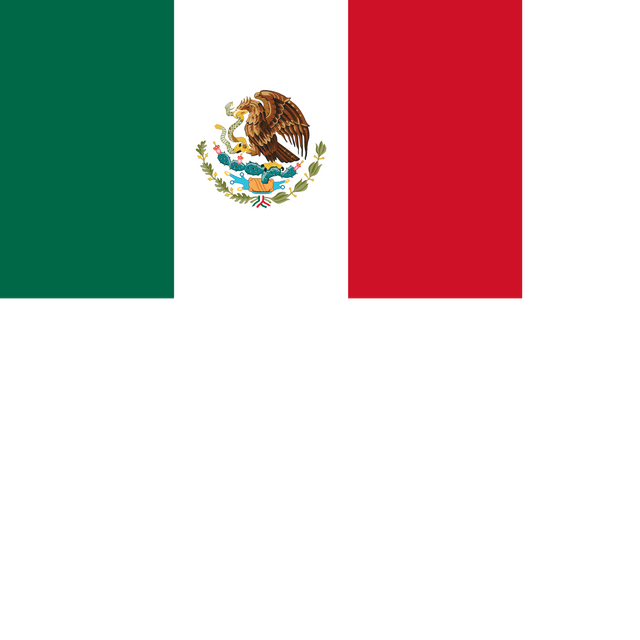
Mexico

| Capital | Mexico City |
|---|---|
| Official languages | |
| Spanishand 68Amerindian languages | |
| National language | Spanish(de facto) |
| Religion | |
| Demonym(s) | Mexican |
| Government | |
| Andrés Manuel López Obrador | |
| Mónica Fernández Balboa | |
| Laura Angélica Rojas Hernández | |
| Legislature | Congress |
| Senate | |
| Chamber of Deputies | |
| Independence | |
| September 16, 1810[4] | |
| September 27, 1821 | |
| December 28, 1836 | |
| October 4, 1824 | |
| February 5, 1857 | |
| February 5, 1917 | |
| Area | |
| 1,972,550 km(761,610 sq mi) (13th) | |
| 2.5 | |
| Population | |
| 126,577,691[5](10th) | |
| 61/km(158.0/sq mi) (142nd) | |
| GDP | 2018 estimate |
| (11th) | |
| $20,645[6](64th) | |
| GDP | 2018 estimate |
| (16th) | |
| $9,614[6](69th) | |
| Gini | |
| HDI | |
| Currency | Peso(MXN) |
| Time zone | (SeeTime in Mexico) |
| (varies) | |
| Driving side | right |
| Calling code | +52 |
| ISO 3166 code | MX |
| Internet TLD | .mx |
Mexico (Spanish: México [ˈmexiko] ( listen); Nahuatl languages: Mēxihco), officially the United Mexican States (UMS; Spanish: Estados Unidos Mexicanos, EUM [11][12][13][14] [esˈtaðos uˈniðos mexiˈkanos] ( listen)), is a country in the southern portion of North America. It is bordered to the north by the United States; to the south and west by the Pacific Ocean; to the southeast by Guatemala, Belize, and the Caribbean Sea; and to the east by the Gulf of Mexico.[15] Covering almost 2,000,000 square kilometers (770,000 sq mi),[14] the nation is the fourth largest country in the Americas by total area and the 13th largest independent state in the world. With an estimated population of over 129 million people,[16] Mexico is the tenth most populous country and the most populous Spanish-speaking country in the world, while being the second most populous nation in Latin America after Brazil.[16] Mexico is a federation comprising 31 states plus Mexico City (CDMX),[17] which is the capital city and its most populous city. Other metropolises in the country include Guadalajara, Monterrey, Puebla, Toluca, Tijuana, and León.[18]
Pre-Columbian Mexico dates to about 8000 BC and is identified as one of six cradles of civilization[19] and was home to many advanced Mesoamerican civilizations such as the Olmec, Toltec, Teotihuacan, Zapotec, Maya, and Aztec before first contact with Europeans. In 1521, the Spanish Empire conquered and colonized the territory from its politically powerful base in Mexico-Tenochtitlan (part of Mexico City), which was administered as the viceroyalty of New Spain. The Roman Catholic Church played a powerful role in governing the country as millions were converted to the faith, although King Charles III expelled the Jesuits in the 1770s.[20] The territory became a nation state following its recognition in 1821 after the Mexican War of Independence.[20] The post-independence period was tumultuous, characterized by economic inequality and many contrasting political changes. The Mexican–American War (1846–1848) led to a territorial loss of part of the huge northern territories to the United States. The Pastry War, the Franco-Mexican War, a civil war, two empires, and the Porfiriato occurred in the 19th century.[20] The Porfiriato ended with the Mexican Revolution in 1910, which culminated in the promulgation of the 1917 Constitution and the emergence of an authoritarian one-party state,[21][22][23][24] once described as the "perfect dictatorship",[25][26][27] that ruled for much of the 20th century until the opposition victories led Mexico to democratic transition in the 1990s.[28][29][30][31]
Mexico has the 15th largest nominal GDP[32] and the 11th largest by purchasing power parity.[33] The Mexican economy is strongly linked to those of its 1994 North American Free Trade Agreement (NAFTA) partners, especially the United States.[34][35] In 1994, Mexico became the first Latin American member of the Organisation for Economic Co-operation and Development (OECD). It is classified as an upper-middle income country by the World Bank[36] and a newly industrialized country by several analysts.[37][38][39][40] The country is considered both a regional power and a middle power,[41][42][43][44] and is often identified as an emerging global power.[45] Due to its rich culture and history, Mexico ranks first in the Americas and seventh in the world for number of UNESCO World Heritage Sites.[46][47][48] Mexico is an ecologically megadiverse country, ranking fifth in the world for its biodiversity.[49] Mexico receives a huge number of tourists every year: in 2018, it was the sixth most-visited country in the world, with 39 million international arrivals.[50] Mexico is a member of the United Nations (UN), the World Trade Organization (WTO), the G8+5, the G20, the Uniting for Consensus group of the UN, and the Pacific Alliance trade bloc.
| Capital | Mexico City |
|---|---|
| Official languages | |
| Spanishand 68Amerindian languages | |
| National language | Spanish(de facto) |
| Religion | |
| Demonym(s) | Mexican |
| Government | |
| Andrés Manuel López Obrador | |
| Mónica Fernández Balboa | |
| Laura Angélica Rojas Hernández | |
| Legislature | Congress |
| Senate | |
| Chamber of Deputies | |
| Independence | |
| September 16, 1810[4] | |
| September 27, 1821 | |
| December 28, 1836 | |
| October 4, 1824 | |
| February 5, 1857 | |
| February 5, 1917 | |
| Area | |
| 1,972,550 km(761,610 sq mi) (13th) | |
| 2.5 | |
| Population | |
| 126,577,691[5](10th) | |
| 61/km(158.0/sq mi) (142nd) | |
| GDP | 2018 estimate |
| (11th) | |
| $20,645[6](64th) | |
| GDP | 2018 estimate |
| (16th) | |
| $9,614[6](69th) | |
| Gini | |
| HDI | |
| Currency | Peso(MXN) |
| Time zone | (SeeTime in Mexico) |
| (varies) | |
| Driving side | right |
| Calling code | +52 |
| ISO 3166 code | MX |
| Internet TLD | .mx |
Etymology
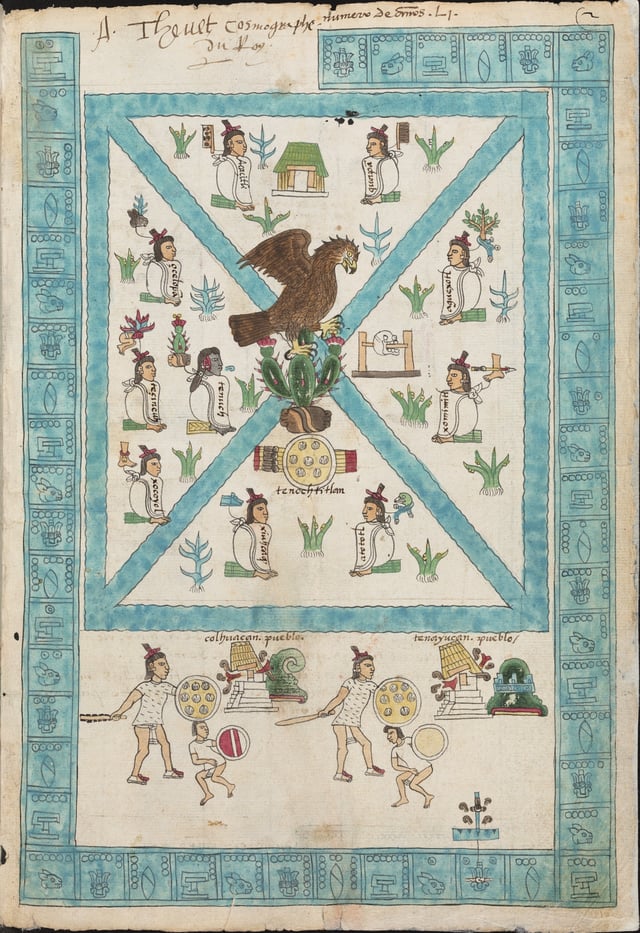
Depiction of the founding myth of Mexico-Tenochtitlan from the Codex Mendoza
Mēxihco is the Nahuatl term for the heartland of the Aztec Empire, namely the Valley of Mexico and surrounding territories, with its people being known as the Mexica. The terms are plainly linked; it is generally believed that the toponym for the valley was the origin of the primary ethnonym for the Aztec Triple Alliance, but it may have been the other way around.[51] In the colonial era, back when Mexico was called New Spain, this territory became the Intendency of Mexico. After New Spain achieved independence from the Spanish Empire, said territory came to be known as the State of Mexico, with the new country being named after its capital: Mexico City, which itself was founded in 1524 on top of the ancient Mexica capital of Mexico-Tenochtitlan.
Traditionally, the name Tenochtitlan was believed to come from Nahuatl tetl [ˈtetɬ] ("rock") and nōchtli [ˈnoːtʃtɬi] ("prickly pear") and is often thought to mean "Among the prickly pears [growing among] rocks". However, one attestation in the late 16th-century manuscript known as "the Bancroft dialogues" suggests the second vowel was short, so that the true etymology remains uncertain.[52]
The suffix -co is the Nahuatl locative, making the word Mexico a place name. Beyond that, the etymology is uncertain. It has been suggested that it is derived from Mextli or Mēxihtli, a secret name for the god of war and patron of the Mexica, Huitzilopochtli, in which case Mēxihco means "place where Huitzilopochtli lives".[53] Another hypothesis suggests that Mēxihco derives from a portmanteau of the Nahuatl words for "moon" (Mētztli) and navel (xīctli).[54] This meaning ("at the navel of the moon") might refer to Tenochtitlan's position in the middle of Lake Texcoco. The system of interconnected lakes, of which Texcoco formed the center, had the form of a rabbit, which the Mesoamericans pareidolically associated with the moon rabbit. Still another hypothesis suggests that the word is derived from Mēctli, the name of the goddess of maguey.[54]
The name of the city-state was transliterated to Spanish as México with the phonetic value of the letter x in Medieval Spanish, which represented the voiceless postalveolar fricative [ʃ]. This sound, as well as the voiced postalveolar fricative [ʒ], represented by a j, evolved into a voiceless velar fricative [x] during the 16th century. This led to the use of the variant Méjico in many publications in Spanish, most notably in Spain, whereas in Mexico and most other Spanish–speaking countries, México was the preferred spelling. In recent years, the Real Academia Española, which regulates the Spanish language, determined that both variants are acceptable in Spanish but that the normative recommended spelling is México.[55] The majority of publications in all Spanish-speaking countries now adhere to the new norm, even though the alternative variant is still occasionally used.[56] In English, the 'x' in Mexico represents neither the original nor the current sound, but the consonant cluster [ks].
The official name of the country has changed as the form of government has changed. The declaration of independence signed on November 6, 1813 by the deputies of the Congress of Anáhuac called the territory América Septentrional (Northern America). On two occasions (1821–1823 and 1863–1867), the country was known as Imperio Mexicano (Mexican Empire). All three federal constitutions (1824, 1857 and 1917, the current constitution) used the name Estados Unidos Mexicanos [57]—or the variant Estados-Unidos Mexicanos,[58] all of which have been translated as "United Mexican States". The phrase República Mexicana, "Mexican Republic", was used in the 1836 Constitutional Laws.[59]
History
Pre-Columbian Mexico
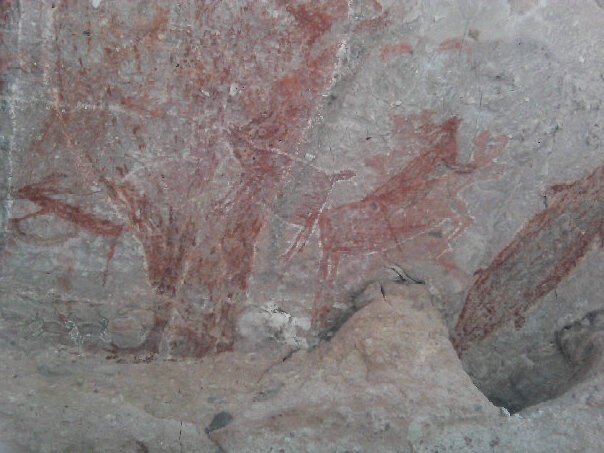
Cave art painting occurred about 7,500 years old in Baja California Peninsula. Culturally and geographically very distinct from Mesoamerica, indigenous peoples inhabited the region since the end of the Pleistocene.[60]
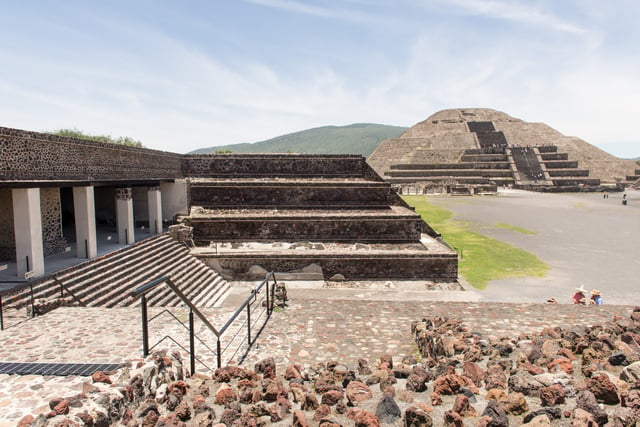
View of the Pyramid of the Moon and entrance to the Quetzalpapálotl Palace. During its peak in the Classic era, Teotihuacán dominated the Valley of Mexico and exerted political and cultural influence in other areas, such as in the Petén Basin.
The earliest human artifacts in Mexico are chips of stone tools found near campfire remains in the Valley of Mexico and radiocarbon-dated to circa 10,000 years ago.[61] Mexico is the site of the domestication of maize, tomato, and beans, which produced an agricultural surplus. This enabled the transition from paleo-Indian hunter-gatherers to sedentary agricultural villages beginning around 5000 BC.[62]
In the subsequent formative eras, maize cultivation and cultural traits such as a mythological and religious complex, and a vigesimal numeric system, were diffused from the Mexican cultures to the rest of the Mesoamerican culture area.[63] In this period, villages became more dense in terms of population, becoming socially stratified with an artisan class, and developing into chiefdoms. The most powerful rulers had religious and political power, organizing the construction of large ceremonial centers developed.[64]
The earliest complex civilization in Mexico was the Olmec culture, which flourished on the Gulf Coast from around 1500 BC. Olmec cultural traits diffused through Mexico into other formative-era cultures in Chiapas, Oaxaca and the Valley of Mexico. The formative period saw the spread of distinct religious and symbolic traditions, as well as artistic and architectural complexes.[65] The formative-era of Mesoamerica is considered one of the six independent cradles of civilization.[19]
In the subsequent pre-classical period, the Maya and Zapotec civilizations developed complex centers at Calakmul and Monte Albán, respectively. During this period the first true Mesoamerican writing systems were developed in the Epi-Olmec and the Zapotec cultures. The Mesoamerican writing tradition reached its height in the Classic Maya Hieroglyphic script.[67]
In Central Mexico, the height of the classic period saw the ascendancy of Teotihuacán, which formed a military and commercial empire whose political influence stretched south into the Maya area as well as north. Teotihuacan, with a population of more than 150,000 people, had some of the largest pyramidal structures in the pre-Columbian Americas.[68] After the collapse of Teotihuacán around 600 AD, competition ensued between several important political centers in central Mexico such as Xochicalco and Cholula. At this time, during the Epi-Classic, Nahua peoples began moving south into Mesoamerica from the North, and became politically and culturally dominant in central Mexico, as they displaced speakers of Oto-Manguean languages.
Post-classic period (ca. 1000–1519 AD)

Mexico-Tenochtitlan Templo Mayor ruins in downtown Mexico City.
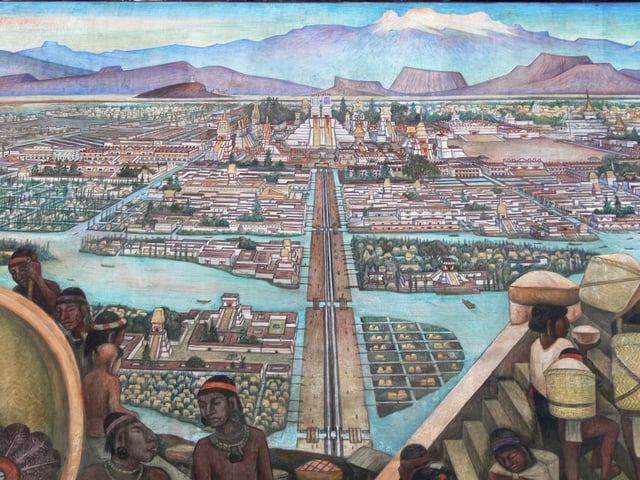
1945 Mural by Diego Rivera depicting the view from the Tlatelolco markets into Mexico-Tenochtitlan, the largest city in the Americas at the time.
During the early post-classic, Central Mexico was dominated by the Toltec culture, Oaxaca by the Mixtec, and the lowland Maya area had important centers at Chichén Itzá and Mayapán.
Toward the end of the post-Classic period, the Mexica established dominance, establishing a political and economic empire based in the city of Tenochtitlan (modern Mexico City), extending from central Mexico to the border with Guatemala.[69]
Alexander von Humboldt popularized the modern usage of "Aztec" as a collective term applied to all the people linked by trade, custom, religion, and language to the Mexica state and Ēxcān Tlahtōlōyān, the Triple Alliance.[70] In 1843, with the publication of the work of William H. Prescott, it was adopted by most of the world, including 19th-century Mexican scholars who considered it a way to distinguish present-day Mexicans from pre-conquest Mexicans. This usage has been the subject of debate since the late 20th century.[71]
The Aztec empire was an informal or hegemonic empire because it did not exert supreme authority over the conquered lands; it was satisfied with the payment of tributes from them.
It was a discontinuous empire because not all dominated territories were connected; for example, the southern peripheral zones of Xoconochco were not in direct contact with the center. The hegemonic nature of the Aztec empire was demonstrated by their restoration of local rulers to their former position after their city-state was conquered. The Aztec did not interfere in local affairs, as long as the tributes were paid.[72]
The Aztec of Central Mexico built a tributary empire covering most of central Mexico.[73] The Aztec were noted for practicing human sacrifice on a large scale. Along with this practice, they avoided killing enemies on the battlefield. Their warring casualty rate was far lower than that of their Spanish counterparts, whose principal objective was immediate slaughter during battle.[74] This distinct Mesoamerican cultural tradition of human sacrifice ended with the gradually Spanish conquest in the 16th century. Over the next centuries many other Mexican indigenous cultures were conquered and gradually subjected to Spanish colonial rule.[75]
Conquest of the Aztec Triple Alliance (1519–1521)
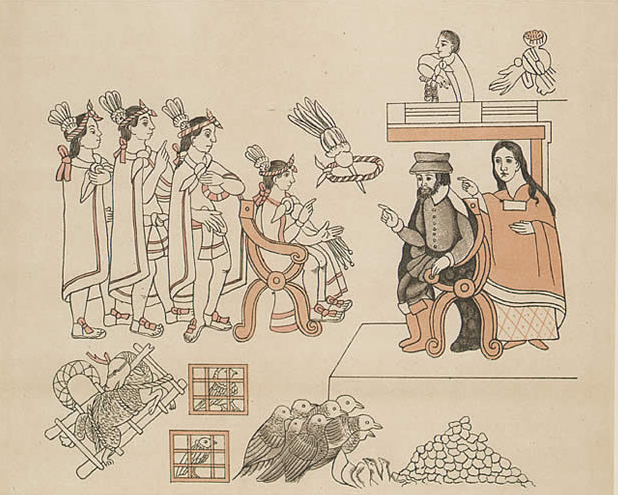
Depict of Hernán Cortés and La Malinche meeting Moctezuma II from the Lienzo de Tlaxcala, created c. 1550 by the Tlaxcalans to remind the Spanish of their loyalty and the importance of Tlaxcala during the conquest.
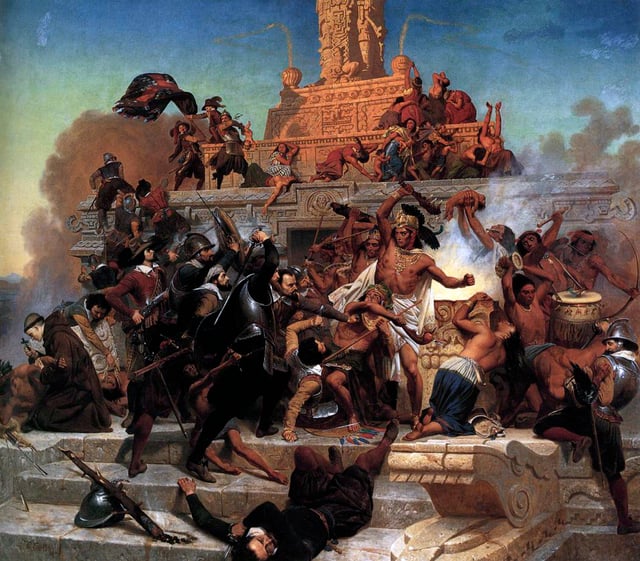
Storming of the Teocalli by Cortés and his troops. Emanuel Leutze. Painting, 1848
The Spanish first learned of Mexico during the Juan de Grijalva expedition of 1518. The natives kept "repeating: Colua, Colua, and Mexico, Mexico, but we [explorers] did not know what Colua or Mexico meant", until encountering Montezuma's governor at the mouth of the Rio de las Banderas.[76] The Spanish conquest of the Aztec Empire began in February 1519 when Hernán Cortés arrived at the port in Veracruz with ca. 500 conquistadores. After taking control of that city, he moved on to the Aztec capital. In his search for gold and other riches, Cortés decided to invade and conquer the Aztec empire.[77]
When the Spaniards arrived, the ruler of the Aztec empire was Moctezuma II, who was later killed. His successor and brother Cuitláhuac took control of the Aztec empire, but was among the first to fall from the first smallpox epidemic in the area a short time later.[78] Unintentionally introduced by Spanish conquerors, among whom smallpox was endemic, the infectious disease ravaged Mesoamerica in the 1520s. It killed more than 3 million natives as they had no immunity.[79] Other sources, however, mentioned that the death toll of the Aztecs might have reached 15 million (out of a population of less than 30 million) although such a high number conflicts with the 350,000 Aztecs who ruled an empire of 5 million or 10 million.[80] Severely weakened, the Aztec empire was easily defeated by Cortés and his forces on his second return with the help of state of Tlaxcala whose population estimate was 300,000.[81] The native population declined 80–90% by 1600 to 1–2.5 million. Any population estimate of pre-Columbian Mexico is bound to be a guess but 8–12 million is often suggested for the area encompassed by the modern nation.
Smallpox was a devastating disease: it generally killed Aztecs but not Spaniards, who as Europeans had already been exposed to it in their cities for centuries and therefore had developed acquired immunity.[82] The deaths caused by smallpox are believed to have triggered a rapid growth of Christianity in Mexico and the Americas. At first, the Aztecs believed the epidemic was a punishment from an angry god, but they later accepted their fate and no longer resisted the Spanish rule.[83] Many of the surviving Aztecs believed that smallpox could be credited to the superiority of the Christian god, which resulted in their acceptance of Catholicism and yielding to the Spanish rule throughout Mexico.[84]
The territory became part of the Spanish Empire under the name of New Spain in 1535.[85] Mexico City was systematically rebuilt by Cortés following the Fall of Tenochtitlan in 1521. Much of the identity, traditions and architecture of Mexico developed during the 286-year colonial period.[86]
Viceroyalty of New Spain (1521–1821)

Equestrian statue of Charles IV, Mexico City, Manuel Tolsá. The Spanish Monarch was the maximum authority in New Spain and ruled via a viceroy.
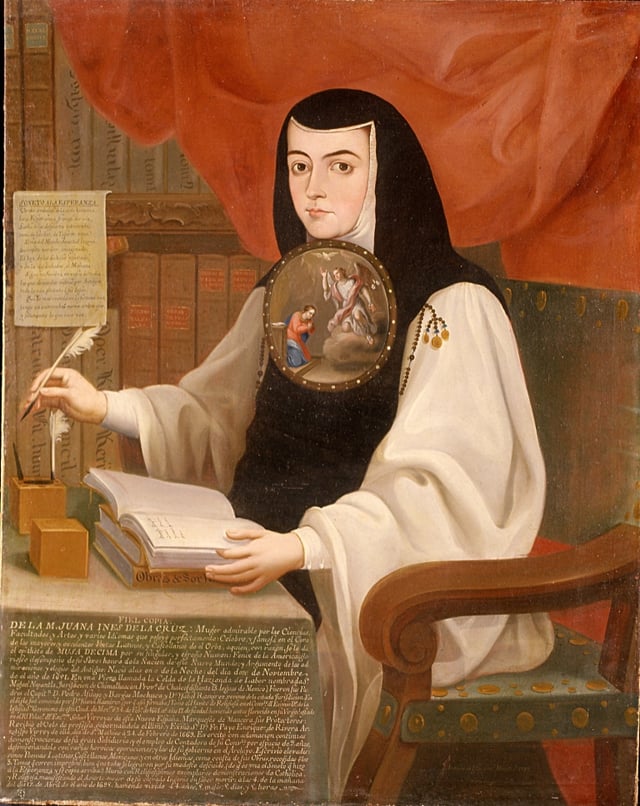
Portrait of Sor Juana Inés de la Cruz, oil on canvas, 1772
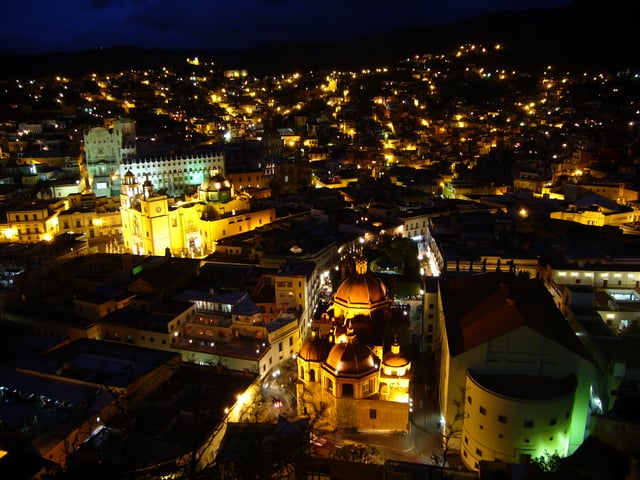
Guanajuato City became the world's leading silver producer in the 18th century as a result of the veta madre
The capture of Tenochtitlan and refounding of Mexico City in 1521 was the beginning of a 286-year-long colonial era during which Mexico was known as Nueva España (New Spain). The Kingdom of New Spain was created from the remnants of the Aztec hegemonic empire. In 1524, King Charles I created the Council of the Indies to rule the country and to limit Hernán Cortés's power, but three years later power was transferred to a court known as the Real Audiencia.[87] Subsequent enlargements, such as the conquest of the Tarascan state, resulted in the creation of the Viceroyalty of New Spain in 1535. The Viceroyalty at its greatest extent included the territories of modern Mexico, Central America as far south as Costa Rica, and the western United States. The Viceregal capital Mexico City also administrated the Spanish West Indies (the Caribbean), the Spanish East Indies (the Philippines), and Spanish Florida.[87]
The indigenous population stabilized around one to one and a half million individuals in the 17th century from the most commonly accepted five to thirty million pre-contact population.[88] The population decline, perhaps between 50%-85% at its height,[88] was primarily the result of communicable diseases, particularly smallpox, introduced during the Columbian Exchange, although some scholars blame the harsh rule and slavery.[88] During the three hundred years of the colonial era, Mexico received between 400,000 and 500,000 Europeans,[89] between 200,000 and 250,000 African slaves.[90] and between 40,000 and 120,000 Asians.[91] The 18th century saw a great increase in the percentage of mestizos.[92]
Colonial law with Spanish roots was introduced and attached to native customs creating a hierarchy between local jurisdiction (the Cabildos) and the Spanish Crown. Upper administrative offices were closed to native-born people, even those of pure Spanish blood (criollos). Administration was based on the racial separation, among "Republics" of Spaniards, Amerindians and castas, autonomous and directly dependent on the king himself.[93]
The Council of Indies and the mendicant religious orders, which arrived in Mesoamerica as early as 1524, labored to generate capital for the crown of Spain and convert the Amerindian populations to Catholicism. The 1531 Marian apparitions to Saint Juan Diego gave impetus to the evangelization of central Mexico.[94][95] The Virgin of Guadalupe became a symbol of criollo patriotism[96] and was used by the insurgents who followed Miguel Hidalgo during the War of Independence.[95] Some Crypto-Jewish families emigrated to Mexico to escape the Spanish Inquisition.
The rich deposits of silver, particularly in Zacatecas and Guanajuato, resulted in silver extraction dominating the economy of New Spain. Taxes on silver production became a major source of income for Spain. Other important industries were the haciendas (functioning under the encomienda and repartimiento systems) and mercantile activities in the main cities and ports.[97] Wealth created during the colonial era spurred the development of New Spanish Baroque.
As a result of its trade links with Asia, the rest of the Americas, Africa and Europe and the profound effect of New World silver, central Mexico was one of the first regions to be incorporated into a globalized economy. Being at the crossroads of trade, people and cultures, Mexico City has been called the "first world city".[98] The Nao de China (Manila Galleons) operated for two and a half centuries and connected New Spain with Asia. Goods were taken from Veracruz to Atlantic ports in the Americas and Spain. Veracruz was also the main port of entry in mainland New Spain for European goods, immigrants, and African slaves. The Camino Real de Tierra Adentro connected Mexico City with the interior of New Spain. Mexican silver pesos became the first globally used currency and the silver mined in Mexico were used to run commerce and wage crusades in two sides of globe, at the Mediterranean, where Spain fought against the Ottoman Caliphate, and at Southeast Asia where the Philippines fought against the Brunei Sultanate.
Due to the importance of New Spain administrative base, Mexico was the location of the first printing shop (1539),[99] first university (1551),[100] first public park (1592),[101] and first public library (1640) in the Americas,[102] among other institutions. Important artists of the colonial period, include the writers Juan Ruiz de Alarcón and Sor Juana Inés de la Cruz, painters Cristóbal de Villalpando and Miguel Cabrera, and architect Manuel Tolsá. The Academy of San Carlos (1781) was the first major school and museum of art in the Americas.[103] Scientist Andrés Manuel del Río Fernández discovered the element vanadium in 1801.[104]
Spanish forces, sometimes accompanied by native allies, led expeditions to conquer territory or quell rebellions through the colonial era.
Notable Amerindian revolts in sporadically populated northern New Spain include the Chichimeca War (1576–1606),[105] Tepehuán Revolt (1616–1620),[106] and the Pueblo Revolt (1680). To protect Mexico from the attacks of English, French, and Dutch pirates and protect the Crown's monopoly of revenue, only two ports were open to foreign trade—Veracruz on the Atlantic and Acapulco on the Pacific. Among the best-known pirate attacks are the 1663 Sack of Campeche[107] and 1683 Attack on Veracruz.[108]
Many Mexican cultural features including tequila,[109] first distilled in the 16th century, charreria (17th),[110] mariachi (18th) and Mexican cuisine, a fusion of American and European (particularly Spanish) cuisine, arose during the colonial era.
War of Independence (1810–1821)
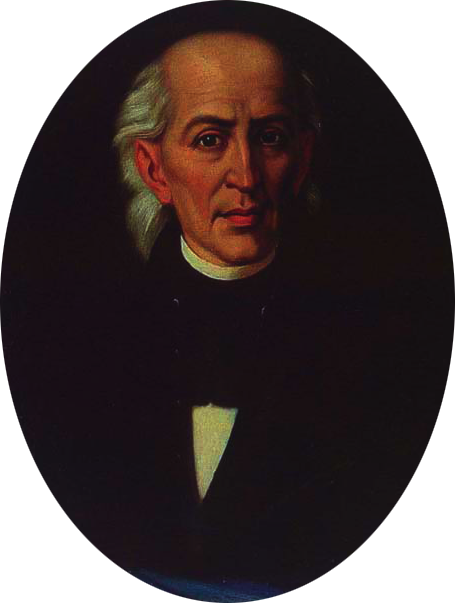
Miguel Hidalgo y Costilla
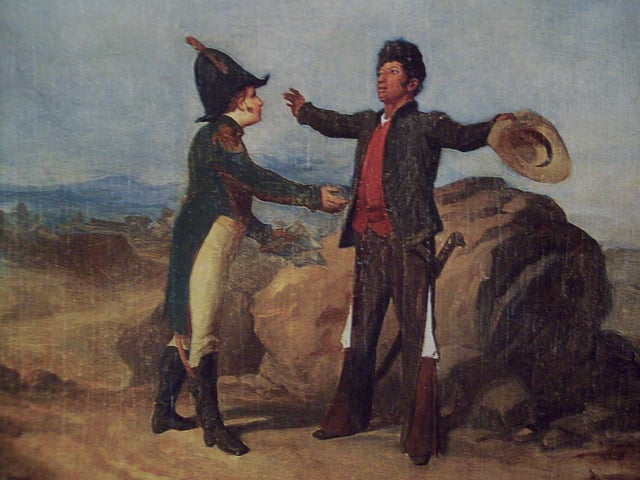
Depiction of the Abrazo de Acatempan between Agustín de Iturbide, left, and Vicente Guerrero
On September 16, 1810, a "loyalist revolt" against the ruling junta was declared by priest Miguel Hidalgo y Costilla, in the small town of Dolores, Guanajuato.[111] This event, known as the Cry of Dolores (Spanish: Grito de Dolores) is commemorated each year, on September 16, as Mexico's independence day.[112] The first insurgent group was formed by Hidalgo, the Spanish viceregal army captain Ignacio Allende, the militia captain Juan Aldama and La Corregidora (English: "The Magistrate") Josefa Ortiz de Domínguez. Hidalgo and some of his soldiers were captured and executed by firing squad in Chihuahua, on July 31, 1811.[113]
Following Hidalgo's death, the leadership was assumed by Ignacio López Rayón and then by the priest José María Morelos, who occupied key southern cities with the support of Mariano Matamoros and Nicolás Bravo.[113] In one notable incident, Nicolas Bravo captured 200 royalist soldiers, whom Morelos ordered should be executed in revenge of the murder of Bravo's father. In an act of mercy, Bravo instead pardoned the prisoners, most of whom then joined the insurgent cause.[113] In 1813 the Congress of Chilpancingo was convened and, on November 6, signed the "Solemn Act of the Declaration of Independence of Northern America". This Act also abolished slavery and the caste system.[113]La%20Evoluc%C3%ADon%20de%20M%C4%97x]][] Morelos was captured and executed on December 22, 1815.[[113]](https://openlibrary.org/search?q=Angel%20Miranda%20Basurto%20%282002%29.%20 [[CITE|113|https://openlibrary.org/search?q=Angel%20Miranda%20Basurto%20%282002%29.%20*La%20Evoluc%C3%ADon%20de%20M%C4%97x)
In subsequent years, the insurgency was near collapse, but in 1820 Viceroy Juan Ruiz de Apodaca sent an army under the criollo general Agustín de Iturbide against the troops of Vicente Guerrero. Instead, Iturbide approached Guerrero to join forces, and on August 24, 1821 representatives of the Spanish Crown and Iturbide signed the "Treaty of Córdoba" and the "Declaration of Independence of the Mexican Empire", which recognized the independence of Mexico under the terms of the "Plan of Iguala".[113]
Mexico's short recovery after the War of Independence was soon cut short again by the civil wars, foreign invasion and occupation, and institutional instability of the mid-19th century, which lasted until the government of Porfirio Díaz reestablished conditions that paved the way for economic growth. The conflicts that arose from the mid-1850s had a profound effect because they were widespread and made themselves perceptible in the vast rural areas of the countries, involved clashes between castes, different ethnic groups, and haciendas, and entailed a deepening of the political and ideological divisions between republicans and monarchists.[114]
First Empire and First Republic (1821–1846)
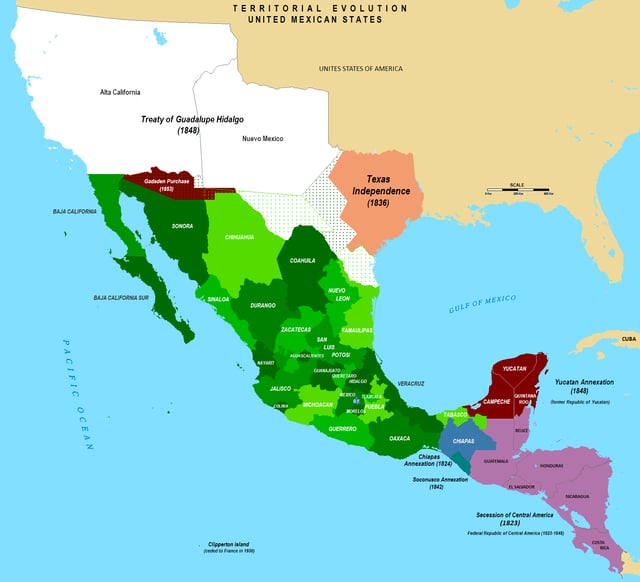
The territorial evolution of Mexico after independence, noting the secession of Central America (purple), Chiapas annexed from Guatemala (blue), losses to the U.S. (red, white and orange) and the reannexation of the Republic of Yucatán (red)
Agustín de Iturbide became constitutional emperor of the First Mexican Empire in 1822.[113] A revolt against him in 1823 established the United Mexican States. In 1824, a Republican Constitution was drafted and Guadalupe Victoria became the first president of the newly born country.[113] Central America, including Chiapas, left the union. In 1829 president Guerrero abolished slavery.[115] The first decades of the post-independence period were marked by a chronic economic instability, which led to the first French invasion in 1836. There was constant strife between Liberals, supporters of a federal form of government, and Conservatives, who proposed a hierarchical form of government.[113]
During this period, the frontier borderlands from north to south, including Jalisco and Yucatan, became quite isolated from the government in Mexico City, and its lack of an industrial base and monopolistic economic policies caused suffering.[113]La%20Evoluc%C3%ADon%20de%20M%C4%97x]][] With limited trade, the people had difficulty meeting tax payments and resented the central government's actions in collecting customs. Resentment built up from California to Texas. Both the mission system and the presidios drew from the colony, causing great disruption especially in Alta California and New Mexico. The people in the borderlands had to raise local militias to protect themselves from hostile Native Americans.[113]La%20Evoluc%C3%ADon%20de%20M%C4%97x]][] These areas developed in different directions from the center of the country.[[116]](https://openlibrary.org/search?q=David%20J.%20Weber%2C%20 [[CITE|116|https://openlibrary.org/search?q=David%20J.%20Weber%2C%20*The%20Mexican%20Frontier%2C%201821%E2%80%931846%3A%20)
Wanting to stabilize and develop the frontier, Mexico encouraged immigration into present-day Texas, as they were unable to persuade people from central Mexico to move into those areas.
They allowed for religious freedom for the new settlers, who were primarily Protestant English speakers from the United States.
Within several years, the Anglos far outnumbered the Tejano in the area. Itinerant traders traveled through the area, working by free-market principles. The Tejano grew more separate from the government and due to its neglect, many supported the idea of independence and joined movements to that end, collaborating with the English-speaking Americans.[116]
General Antonio López de Santa Anna, a centralist and two-time dictator, approved the Siete Leyes (Seven Laws) in 1836, a radical amendment that institutionalized the centralized form of government. When he suspended the 1824 Constitution, civil war spread across the country. Three new governments declared independence: the Republic of Texas, the Republic of the Rio Grande and the Republic of Yucatán.[113]
Second Republic and Second Empire (1846–1867)

Benito Juárez, 26th President of Mexico and implanter of La Reforma
The 1846 United States annexation of the Republic of Texas and subsequent American military incursion into territory that was part of Coahuila (also claimed by Texas) instigated the Mexican–American War. 26,922 regular U.S. soldiers and 73,260 volunteers served at some time during the war;[117] including those killed and wounded in action and killed by disease, total U.S. have been over 27,000.[113] The Mexican army was comparable in size, although its soldiers were poorly equipped, poorly trained, and poorly organized. Major battles were fought in Monterrey, Buena Vista, Veracruz, Cerro Gordo, Padierna, and the military academy at Chapultepec. Hundreds of civilians were killed during the three-day bombardment of Veracruz[118] Six teenage cadets were killed during the final defense of Mexico City at Chapultepec. The war was settled in 1848 via the Treaty of Guadalupe Hidalgo.[113] Mexico was forced to give up more than one-third of its land (2,378,000 km2 (918,000 sq mi)) to the U.S., including Alta California, Santa Fe de Nuevo México and the territory claimed by Texas.[113] A much smaller transfer of territory in what is today southern Arizona and southwestern New Mexico—known as the Gadsden Purchase—occurred in 1854.[119]
Dissatisfaction with Santa Anna's return to power led to the liberal "Plan of Ayutla", initiating an era known as La Reforma ("The Reform"). The new Constitution drafted in 1857 established a secular state, federalism as the form of government, civil marriage, freedom of the press, and educational freedom (lay education).[123][113] As the Conservatives refused to recognize it, the Reform War began in 1858, during which both groups had their own governments. The war ended in 1861 with victory by the Liberals, led by president Benito Juárez,[113] who was an ethnic Zapotec.
By 1861, 91% of the government's income was destined for payment of the foreign debt or maintenance of the army, leaving only 9% for everything else.
Juarez decided to suspend debt payments for two years, prompting England, France, and Spain to agree to military intervention.
Juarez negotiated with representatives of the three countries after they occupied the port of Veracruz until a French warship arrived and the captain announced they intended to overthrow the elected president and install conservative Juan Almonte as president. Upon learning this the French and English ships withdrew, but the French decided to advance on the city of Puebla.[113] General Ignacio Zaragoza defeated the invaders at the Battle of Puebla on May 5, 1862,[113]La%20Evoluc%C3%ADon%20de%20M%C4%97x]][] which is widely celebrated as the and the United States.[124] Following this French defeat, emperor Napoleon III sent 50,000 reinforcements and on March 16, 1863 fought a second battle in Puebla, easily defeating the Mexican army led by Jesús González Ortega.[113]
Juarez was forced to retreat north, and the conservatives offered a throne to Archduke Ferdinand Maximilian of Austria. Maximilian established the Second Mexican Empire in 1864, quickly surrounding himself with liberals and adopting many of the policies of the Reforma. Meanwhile, Napoleon III feared a European war and withdrew his troops in 1866. The Republicans were able to defeat the empire, and Maximilian was captured and executed in Querétaro on June 19, 1867.[113]
Porfiriato (1876–1911)
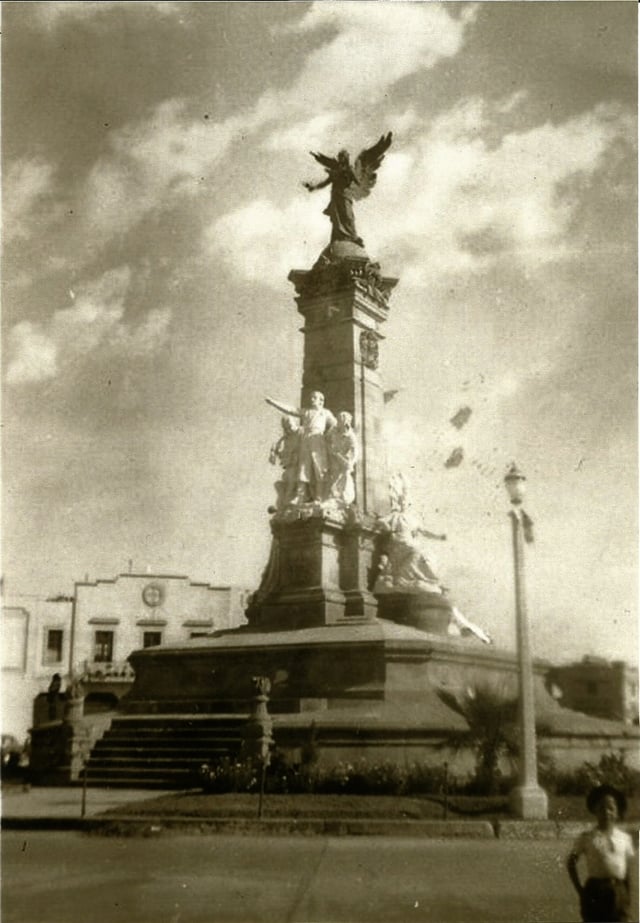
Angel of Independence in Mexico City was built during Porfiriato.
Porfirio Díaz, a republican general during the French intervention, was elected the 29th president in 1876. The 1880 election was won by Manuel González Flores. Díaz was reelected in 1884 and ruled until 1911. The period, known as the Porfiriato, was characterized by economic stability and growth, significant foreign investment and influence, investments in the arts and sciences and an expansion of the railroad network and telecommunications.[125] The period was concurrent with the Gilded Age in the U.S. and Belle Époque in France and was also marked by economic inequality, and political repression. The economy has been described as semi-colonial, as foreign (mostly British and American) investment was encouraged at the expense of the Mexican people and land was controlled by local caciques (petty tyrants).[113]
Díaz ruled with a group of confidants that became known as the científicos ("scientists"). The most influential cientifco was Secretary of Finance José Yves Limantour. The Porfirian regime was influenced by positivism.[126] They rejected theology and idealism in favor of scientific methods being applied towards national development.[126] Various iconic buildings and monuments were initiated by Díaz, including the Palacio de Bellas Artes, Palacio de Correos de Mexico, Monumento a la Independencia and the Palacio Legislativo (which became the Monumento a la Revolución).
Mexican Revolution (1910–1920)
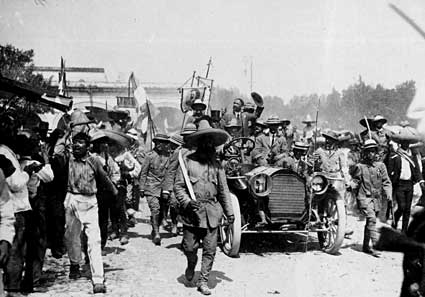
Francisco I. Madero with Emiliano Zapata, in Cuernavaca during the Mexican Revolution
President Díaz announced in 1908 that he would retire in 1911, resulting in the development of new coalitions.
But then he ran for reelection anyway and in a show of U.S. support, Díaz and William Howard Taft planned a summit in El Paso, Texas, and Ciudad Juárez, Mexico, for October 16, 1909, an historic first meeting between a Mexican and a U.S. president and also the first time an American president would cross the border into Mexico.[127] Both sides agreed that the disputed Chamizal strip connecting El Paso to Ciudad Juárez would be considered neutral territory with no flags present during the summit, but the meeting focused attention on this territory and resulted in assassination threats and other serious security concerns.[127]
On the day of the summit, Frederick Russell Burnham, the celebrated scout, and Private C.R. Moore, a Texas Ranger, discovered a man holding a concealed palm pistol standing at the El Paso Chamber of Commerce building along the procession route, and they disarmed the assassin within only a few feet of Díaz and Taft.[127] Both presidents were unharmed and the summit was held.[127] Díaz was re-elected in 1910, but alleged electoral fraud forced him into exile in France and sparked the 1910 Mexican Revolution, initially led by Francisco I. Madero.
Madero was elected president but overthrown and murdered in a coup d'état two years later directed by conservative general Victoriano Huerta. That event re-ignited the civil war, involving figures such as Francisco Villa and Emiliano Zapata, who formed their own forces. A third force, the constitutional army led by Venustiano Carranza managed to bring an end to the war, and radically amended the 1857 Constitution to include many of the social premises and demands of the revolutionaries into what was eventually called the 1917 Constitution. It is estimated that the war killed 900,000 of the 1910 population of 15 million.[128][129]
U.S.interference in the internal affairs of Mexico was notorious.
American troops were sent to put down the 1906 Cananea strike, and President Taft's Administration, U.S. officials often protected investors' interests over helping end the brutalities of the Diaz regime. The U.S. government supported the anti-reelectionist movement, agreed with Bernardo Reyes and Félix Díaz's revolt against Francisco I. Madero, helped the revolutionaries defeat Huerta, and invaded Veracruz in 1914.[130] Following an incursion into Columbus, New Mexico, the U.S. sent 10,000 troops led by General John J. Pershing in an unsuccessful attempt to capture Pancho Villa.[131] The Zimmermann Telegram of 1917 involved an attempt by Germany to incite a war between the U.S. and Mexico.[132]
As part of his plan to consolidate power, Carranza had peasant-leader Emiliano Zapata assassinated in 1918.[113] President Carranza was assassinated in 1920, and Adolfo de la Huerta became interim president, followed by General Álvaro Obregón. Obregon instituted land redistribution and pushed public education. Plutarco Elías Calles became president in 1924; his goal was to improve the finances of the country by establishing the Banco de Mexico (Bank of Mexico) and the Banco de Credito Ágricola (Agricultural Credit Bank). Calles wanted to enforce the anti-clerical aspects of the 1917 Constitution, sparking the Cristero War, particularly in the western part of the country.[113]
Obregon was elected a second time in 1928, only to be assassinated two weeks before taking office. This was the period known as the Maximato, when Calles dominated Mexican politics as its "Maximum Leader". Calles declared that the Revolution had moved from caudillismo (strongmen) to the era institucional (institutional era). To this end, he founded the "National Revolutionary Party" (PRN), precursor to the Institutional Revolutionary Party that ruled the country as a one-party state for 70 years.[133]
Early-20th-century stability and one-party rule (1920–2000)
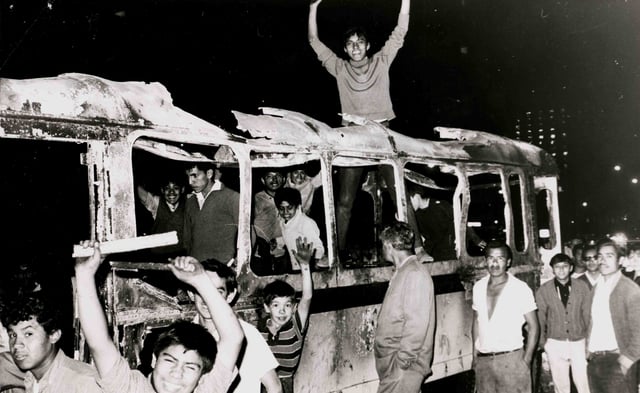
Students in a burned bus during the protests of 1968
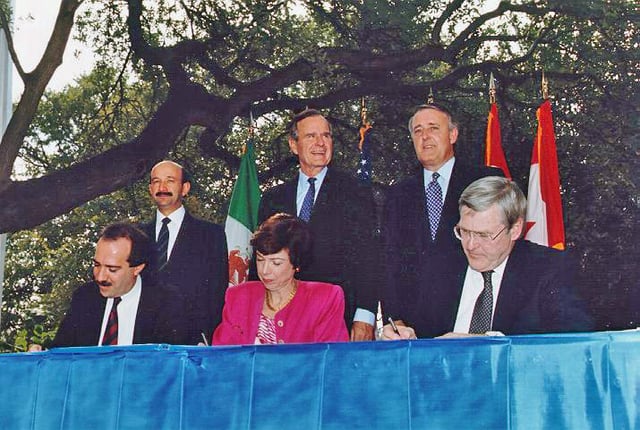
NAFTA signing ceremony, October 1992. From left to right: (standing) President Carlos Salinas de Gortari (Mexico), President George H. W. Bush (U.S.), and Prime Minister Brian Mulroney (Canada); (seated) Jaime Serra Puche (Mexico), Carla Hills (U.S.), and Michael Wilson (Canada)
In 1929, revolutionary general and former president of Mexico Plutarco Elías Calles founded the National Revolutionary Party (PNR), later renamed the Institutional Revolutionary Party (PRI). Despite not holding the presidency, Calles remained the key political figure during the period known as the Maximato (1929-1934). The Maximato ended during the presidency of Lázaro Cárdenas, who expelled Calles from the country and implemented many economic and social reforms. This included the Mexican oil expropriation in March 1938, which nationalized the U.S. and Anglo-Dutch oil company known as the Mexican Eagle Petroleum Company. This movement would result in the creation of the state-owned Mexican oil company Pemex. This sparked a diplomatic crisis with the countries whose citizens had lost businesses by Cárdenas's radical measure, but since then the company has played an important role in the economic development of Mexico. Cárdenas's successor, Manuel Ávila Camacho (1940-1946) was more moderate, and relations between the U.S. and Mexico vastly improved during World War II, when Mexico was a significant ally, providing manpower and materiel to aid the war effort. In 1946 with the election of Miguel Alemán, the first civilian president in the post-revolutionary period, Mexico embarked on an aggressive program of economic development, known as the Mexican miracle, which was characterized by industrialization, urbanization, and the increase of inequality in Mexico between urban and rural areas.[134]
Although the economy continued to flourish for some, social inequality remained a factor of discontent. Moreover, the PRI rule became increasingly authoritarian and at times oppressive in what is now referred to as 'Mexico's dirty war'[135] (see the 1968 Tlatelolco massacre,[136] which claimed the life of around 300 protesters based on conservative estimates and as many as 800 by the protesters).[137]
Electoral reforms and high oil prices followed the administration of Luis Echeverría,[138][139] mismanagement of these revenues led to inflation and exacerbated the 1982 Crisis. That year, oil prices plunged, interest rates soared, and the government defaulted on its debt. President Miguel de la Madrid resorted to currency devaluations which in turn sparked inflation.
In the 1980s the first cracks emerged in PRI's dominance.
In Baja California, Ernesto Ruffo Appel was elected as governor. In 1988, alleged electoral fraud prevented the leftist candidate Cuauhtémoc Cárdenas from winning the national presidential elections, giving Carlos Salinas de Gortari the presidency and leading to massive protests in Mexico City.[140]
Salinas embarked on a program of neoliberal reforms which fixed the exchange rate, controlled inflation, and culminated with the signing of the North American Free Trade Agreement (NAFTA), which came into effect on January 1, 1994. The same day, the Zapatista Army of National Liberation (EZLN) started a two-week-long armed rebellion against the federal government, and has continued as a non-violent opposition movement against neoliberalism and globalization.
In 1994, Salinas was succeeded by Ernesto Zedillo, followed by the Mexican peso crisis and a $50 billion IMF bailout. Major macroeconomic reforms were started by President Zedillo, and the economy rapidly recovered and growth peaked at almost 7% by the end of 1999.[141]
Contemporary Mexico
In 2000, after 71 years, the PRI lost a presidential election to Vicente Fox of the opposition National Action Party (PAN). In the 2006 presidential election, Felipe Calderón from the PAN was declared the winner, with a very narrow margin (0.58%) over leftist politician Andrés Manuel López Obrador of the Party of the Democratic Revolution (PRD).[142] López Obrador, however, contested the election and pledged to create an "alternative government".[143]
After twelve years, in 2012, the PRI won the presidency again with the election of Enrique Peña Nieto, the governor of the State of Mexico from 2005 to 2011. However, he won with a plurality of about 38%, and did not have a legislative majority.[144]
In his third presidential run, former mayor of Mexico City Andrés Manuel López Obrador won the 2018 presidential election with over 50% of the vote.
His political coalition, led by a left-wing party MORENA, which was founded after the 2012 elections by Andres, includes parties and politicians from all over the political spectrum and also obtained a majority in both the upper and lower congress chambers. AMLO's (one of his many nicknames) success is attributed to the country's other strong political alternatives exhausting their chances as well as the politician adopting a moderate discourse with focus in conciliation.[145]
Geography
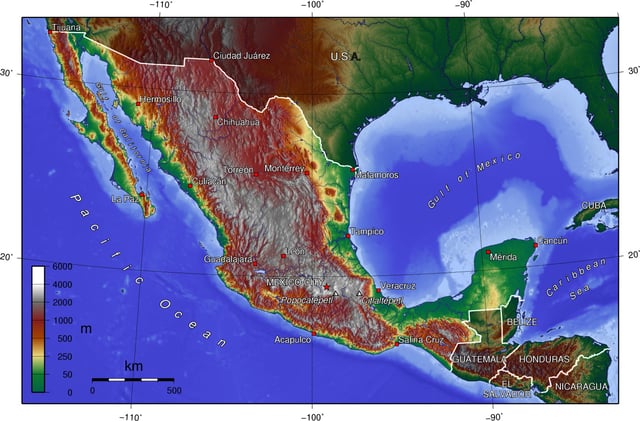
Topographic map of Mexico
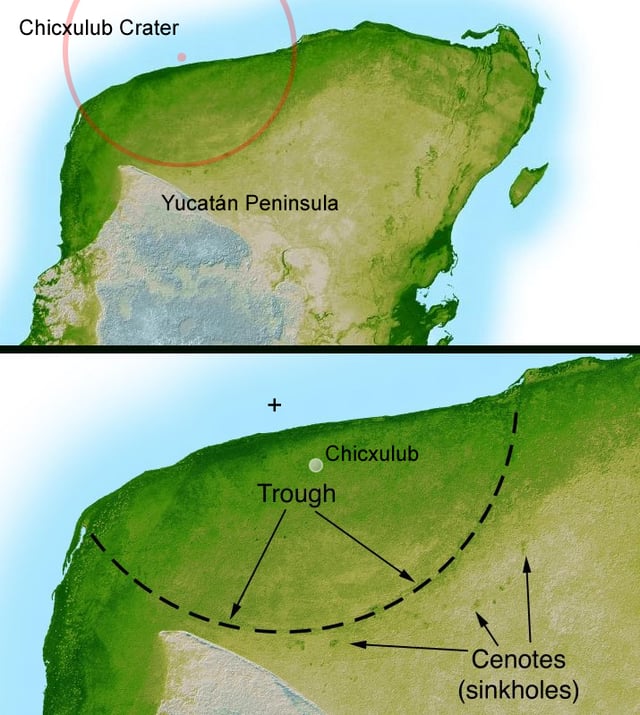
Location in the Yucatán peninsula of the Chicxulub crater. The scientific consensus is that the Chicxulub impactor was responsible for the Cretaceous–Paleogene extinction event.
Mexico is located between latitudes 14° and 33°N, and longitudes 86° and 119°W in the southern portion of North America. Almost all of Mexico lies in the North American Plate, with small parts of the Baja California peninsula on the Pacific and Cocos Plates. Geophysically, some geographers include the territory east of the Isthmus of Tehuantepec (around 12% of the total) within Central America.[146] Geopolitically, however, Mexico is entirely considered part of North America, along with Canada and the United States.[147]
Mexico's total area is 1,972,550 km2 (761,606 sq mi), making it the world's 13th largest country by total area. It has coastlines on the Pacific Ocean and Gulf of California, as well as the Gulf of Mexico and Caribbean Sea, the latter two forming part of the Atlantic Ocean.[148] Within these seas are about 6,000 km2 (2,317 sq mi) of islands (including the remote Pacific Guadalupe Island and the Revillagigedo Islands). From its farthest land points, Mexico is a little over 2,000 mi (3,219 km) in length.
On its north, Mexico shares a 3,141 km (1,952 mi) border with the United States. The meandering Río Bravo del Norte (known as the Rio Grande in the United States) defines the border from Ciudad Juárez east to the Gulf of Mexico. A series of natural and artificial markers delineate the United States-Mexican border west from Ciudad Juárez to the Pacific Ocean. Donald Trump made the construction of a border wall (on the U.S. side) an element of his 2016 presidential campaign. On its south, Mexico shares an 871 km (541 mi) border with Guatemala and a 251 km (156 mi) border with Belize.
Mexico is crossed from north to south by two mountain ranges known as Sierra Madre Oriental and Sierra Madre Occidental, which are the extension of the Rocky Mountains from northern North America. From east to west at the center, the country is crossed by the Trans-Mexican Volcanic Belt also known as the Sierra Nevada. A fourth mountain range, the Sierra Madre del Sur, runs from Michoacán to Oaxaca.[149]
As such, the majority of the Mexican central and northern territories are located at high altitudes, and the highest elevations are found at the Trans-Mexican Volcanic Belt: Pico de Orizaba (5,700 m or 18,701 ft), Popocatépetl (5,462 m or 17,920 ft) and Iztaccihuatl (5,286 m or 17,343 ft) and the Nevado de Toluca (4,577 m or 15,016 ft). Three major urban agglomerations are located in the valleys between these four elevations: Toluca, Greater Mexico City and Puebla.[149]
Climate

Mexico map of Köppen climate classification
The Tropic of Cancer effectively divides the country into temperate and tropical zones. Land north of the twenty-fourth parallel experiences cooler temperatures during the winter months. South of the twenty-fourth parallel, temperatures are fairly constant year round and vary solely as a function of elevation. This gives Mexico one of the world's most diverse weather systems.
Areas south of the 24th parallel with elevations up to 1,000 m (3,281 ft) (the southern parts of both coastal plains as well as the Yucatán Peninsula), have a yearly median temperature between 24 to 28 °C (75.2 to 82.4 °F). Temperatures here remain high throughout the year, with only a 5 °C (9 °F) difference between winter and summer median temperatures. Both Mexican coasts, except for the south coast of the Bay of Campeche and northern Baja, are also vulnerable to serious hurricanes during the summer and fall. Although low-lying areas north of the 24th parallel are hot and humid during the summer, they generally have lower yearly temperature averages (from 20 to 24 °C or 68.0 to 75.2 °F) because of more moderate conditions during the winter.
Many large cities in Mexico are located in the Valley of Mexico or in adjacent valleys with altitudes generally above 2,000 m (6,562 ft).
This gives them a year-round temperate climate with yearly temperature averages (from 16 to 18 °C or 60.8 to 64.4 °F) and cool nighttime temperatures throughout the year.
Many parts of Mexico, particularly the north, have a dry climate with sporadic rainfall while parts of the tropical lowlands in the south average more than 2,000 mm (78.7 in) of annual precipitation.
For example, many cities in the north like Monterrey, Hermosillo, and Mexicali experience temperatures of 40 °C (104 °F) or more in summer. In the Sonoran Desert temperatures reach 50 °C (122 °F) or more.
In 2012, Mexico passed a comprehensive climate change bill, a first in the developing world, that has set a goal for the country to generate 35% of its energy from clean energy sources by 2024, and to cut emissions by 50% by 2050, from the level found in 2000.[150][151] During the 2016 North American Leaders' Summit, the target of 50% of electricity generated from renewable sources by 2025 was announced.[152]
Biodiversity

Axolotl, endemic to Valle de México.
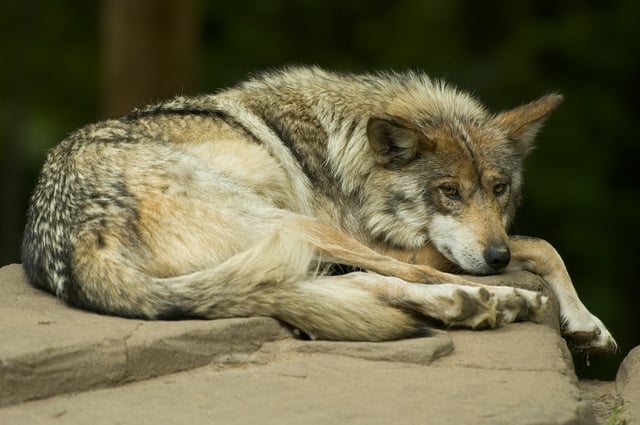
Mexican wolf.
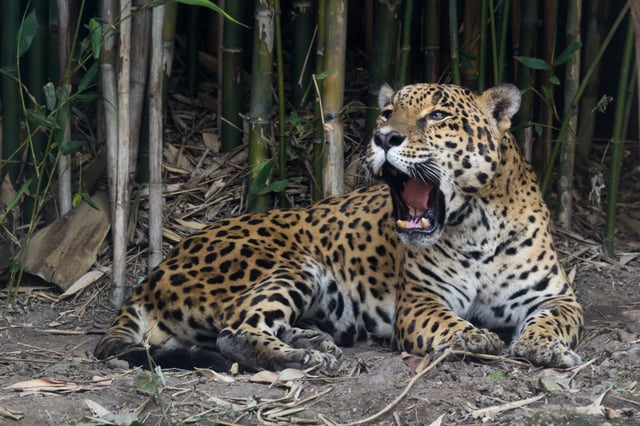
A jaguar at the Chapultepec Zoo. The zoo is known for its success in breeding programs of threatened species.
Mexico ranks fourth[153] in the world in biodiversity and is one of the 17 megadiverse countries. With over 200,000 different species, Mexico is home of 10–12% of the world's biodiversity.[154] Mexico ranks first in biodiversity in reptiles with 707 known species, second in mammals with 438 species, fourth in amphibians with 290 species, and fourth in flora, with 26,000 different species.[155] Mexico is also considered the second country in the world in ecosystems and fourth in overall species.[156] About 2,500 species are protected by Mexican legislations.[156]
In 2002, Mexico had the second fastest rate of deforestation in the world, second only to Brazil.[157] The government has taken another initiative in the late 1990s to broaden the people's knowledge, interest and use of the country's esteemed biodiversity, through the Comisión Nacional para el Conocimiento y Uso de la Biodiversidad.
In Mexico, 170,000 square kilometres (65,637 sq mi) are considered "Protected Natural Areas".
These include 34 biosphere reserves (unaltered ecosystems), 67 national parks, 4 natural monuments (protected in perpetuity for their aesthetic, scientific or historical value), 26 areas of protected flora and fauna, 4 areas for natural resource protection (conservation of soil, hydrological basins and forests) and 17 sanctuaries (zones rich in diverse species).[154]
The discovery of the Americas brought to the rest of the world many widely used food crops and edible plants. Some of Mexico's native culinary ingredients include: chocolate, avocado, tomato, maize, vanilla, guava, chayote, epazote, camote, jícama, nopal, zucchini, tejocote, huitlacoche, sapote, mamey sapote, many varieties of beans, and an even greater variety of chiles, such as the habanero and the jalapeño. Most of these names come from indigenous languages like Nahuatl.
Government and politics
Government

President Andrés Manuel López Obrador, assumed office on December 1, 2018
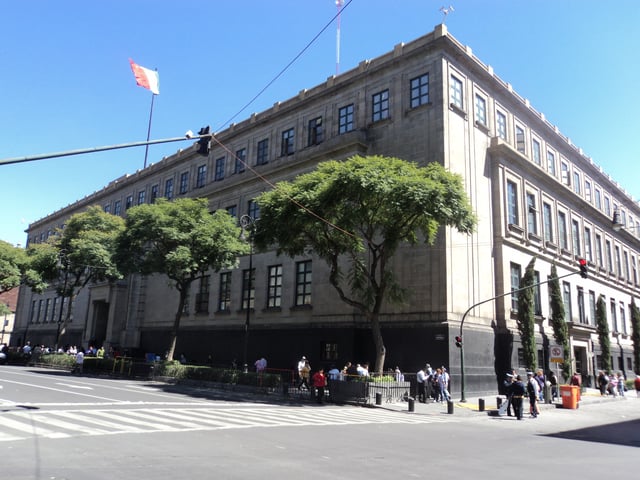
Site of the Supreme Court of Justice
The United Mexican States are a federation whose government is representative, democratic and republican based on a presidential system according to the 1917 Constitution. The constitution establishes three levels of government: the federal Union, the state governments and the municipal governments. According to the constitution, all constituent states of the federation must have a republican form of government composed of three branches: the executive, represented by a governor and an appointed cabinet, the legislative branch constituted by a unicameral congress [160] and the judiciary, which will include a state Supreme Court of Justice. They also have their own civil and judicial codes.
The federal legislature is the bicameral Congress of the Union, composed of the Senate of the Republic and the Chamber of Deputies. The Congress makes federal law, declares war, imposes taxes, approves the national budget and international treaties, and ratifies diplomatic appointments.[161]
The federal Congress, as well as the state legislatures, are elected by a system of parallel voting that includes plurality and proportional representation.[162] The Chamber of Deputies has 500 deputies. Of these, 300 are elected by plurality vote in single-member districts (the federal electoral districts) and 200 are elected by proportional representation with closed party lists[162] for which the country is divided into five electoral constituencies.[162] The Senate is made up of 128 senators. Of these, 64 senators (two for each state and two for Mexico City) are elected by plurality vote in pairs; 32 senators are the first minority or first-runner up (one for each state and one for Mexico City), and 32 are elected by proportional representation from national closed party lists.[162]
The executive is the President of the United Mexican States, who is the head of state and government, as well as the commander-in-chief of the Mexican military forces. The President also appoints the Cabinet and other officers. The President is responsible for executing and enforcing the law, and has the power to veto bills.[161]
The highest organ of the judicial branch of government is the Supreme Court of Justice, the national supreme court, which has eleven judges appointed by the President and approved by the Senate. The Supreme Court of Justice interprets laws and judges cases of federal competency. Other institutions of the judiciary are the Federal Electoral Tribunal, collegiate, unitary and district tribunals, and the Council of the Federal Judiciary.[161]
Politics
Three parties have historically been the dominant parties in Mexican politics: the Institutional Revolutionary Party (PRI), a center-left party and member of Socialist International[167] that was founded in 1929 to unite all the factions of the Mexican Revolution and held an almost hegemonic power in Mexican politics since then; the National Action Party (PAN), a conservative party founded in 1939 and belonging to the Christian Democrat Organization of America;[168] and the Party of the Democratic Revolution (PRD) a left-wing party,[169] founded in 1989 as the successor of the coalition of socialists and liberal parties. PRD emerged after what has now been proven was a stolen election in 1988,[170] and has won numerous state and local elections since then. PAN won its first governorship in 1989, and won the presidency in 2000 and 2006.[171]
A new political party, National Regeneration Movement (MORENA), a leftist-populist party, emerged after the 2012 election and dominated the 2018 Mexican general election.[172]
Law enforcement

Federal Police headquarters in Mexico City
Public security is enacted at the three levels of government, each of which has different prerogatives and responsibilities.
Local and state police departments are primarily in charge of law enforcement, whereas the Mexican Federal Police are in charge of specialized duties. All levels report to the Secretaría de Seguridad Pública (Secretary of Public Security). The General Attorney's Office (Procuraduría General de la República, PGR) is the executive power's agency in charge of investigating and prosecuting crimes at the federal level, mainly those related to drug and arms trafficking,[173] espionage, and bank robberies.[174] The PGR operates the Federal Ministerial Police (Policia Federal Ministerial, PMF) an investigative and preventive agency.[175]
While the government generally respects the human rights of its citizens, serious abuses of power have been reported in security operations in the southern part of the country and in indigenous communities and poor urban neighborhoods.[176] The National Human Rights Commission has had little impact in reversing this trend, engaging mostly in documentation but failing to use its powers to issue public condemnations to the officials who ignore its recommendations.[177] By law, all defendants have the rights that assure them fair trials and humane treatment; however, the system is overburdened and overwhelmed with several problems.[176]
Despite the efforts of the authorities to fight crime and fraud, most Mexicans have low confidence in the police or the judicial system, and therefore, few crimes are actually reported by the citizens.[176] The Global Integrity Index which measures the existence and effectiveness of national anti-corruption mechanisms rated Mexico 31st behind Kenya, Thailand, and Russia.[178] In 2008, president Calderón proposed a major reform of the judicial system, which was approved by the Congress of the Union, which included oral trials, the presumption of innocence for defendants, the authority of local police to investigate crime—until then a prerogative of special police units—and several other changes intended to speed up trials.[179]
Crime
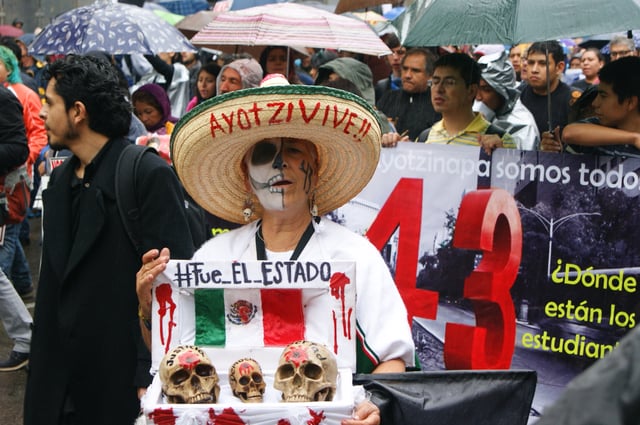
Demonstration on September 26, 2015, in the first anniversary of the disappearance of the 43 students in the Mexican town of Iguala
Drug cartels are a major concern in Mexico.[180] Mexico's drug war (2006-2019) left over 120,000 dead and perhaps another 37,000 missing.[181] The Mexican drug cartels have as many as 100,000 members.[182] Mexico's National Geography and Statistics Institute estimated that in 2014, one-fifth of Mexicans were victims of some sort of crime.[183]
President Felipe Calderón made eradicating organized crime one of the top priorities of his administration by deploying military personnel to cities where drug cartels operate. This move was criticized by the opposition parties and the National Human Rights Commission for escalating the violence,[184] but its effects have been positively evaluated by the US State Department's Bureau for International Narcotics and Law Enforcement Affairs as having obtained "unprecedented results" with "many important successes".[185]
Since President Felipe Calderón launched a crackdown against cartels in 2006, more than 28,000 alleged criminals have been successfully killed.[186][187] Of the total drug-related violence 4% are innocent people,[188] mostly by-passers and people trapped in between shootings; 90% accounts for criminals and 6% for military personnel and police officers.[188] In October 2007, President Calderón and US president George W. Bush announced the Mérida Initiative, a plan of law enforcement cooperation between the two countries.[189]
The mass kidnapping of the 43 students in Iguala on September 26, 2014 triggered nationwide protests against the government's weak response to the disappearances and widespread corruption that gives free rein to criminal organizations.[192]
Foreign relations
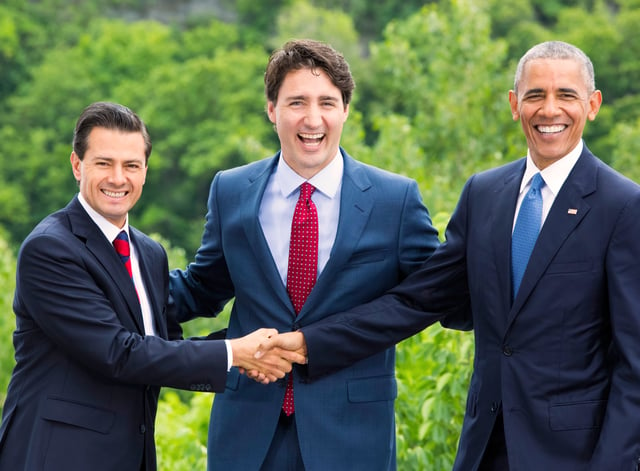
Former President Enrique Peña Nieto with Prime Minister Justin Trudeau of Canada and President Barack Obama of the United States at the 2016 North American Leaders' Summit
The foreign relations of Mexico are directed by the President of Mexico[193] and managed through the Ministry of Foreign Affairs.[194] The principles of the foreign policy are constitutionally recognized in the Article 89, Section 10, which include: respect for international law and legal equality of states, their sovereignty and independence, trend to non-interventionism in the domestic affairs of other countries, peaceful resolution of conflicts, and promotion of collective security through active participation in international organizations.[193] Since the 1930s, the Estrada Doctrine has served as a crucial complement to these principles.[195]
Mexico is founding member of several international organizations, most notably the United Nations,[196] the Organization of American States,[197] the Organization of Ibero-American States,[198] the OPANAL[199] and the Rio Group.[200] In 2008, Mexico contributed over 40 million dollars to the United Nations regular budget.[201] In addition, it was the only Latin American member of the Organisation for Economic Co-operation and Development since it joined in 1994 until Chile gained full membership in 2010.[202][203]
Mexico is considered a regional power[43][44] hence its presence in major economic groups such as the G8+5 and the G-20. In addition, since the 1990s Mexico has sought a reform of the United Nations Security Council and its working methods[206] with the support of Canada, Italy, Pakistan and other nine countries, which form a group informally called the Coffee Club.[207]
After the War of Independence, the relations of Mexico were focused primarily on the United States, its northern neighbor, largest trading partner,[208] and the most powerful actor in hemispheric and world affairs.[209] Mexico supported the Cuban government since its establishment in the early 1960s,[210] the Sandinista revolution in Nicaragua during the late 1970s,[211] and leftist revolutionary groups in El Salvador during the 1980s.[212] Felipe Calderón's administration (2006-2012) put a greater emphasis on relations with Latin America and the Caribbean.[213] Enrique Peña Nieto (2012-2018) emphasized economic issues and foreign investment, particularly the now-defunct Trans-Pacific Partnership.[214] Andrés Manuel López Obrador has taken a cautious approach, unwilling to challenge U.S. President Donald Trump on either trade or migration, while maintaining neutrality on Venezuela and welcoming Chinese money.[215]
Military

A Mexican Navy Eurocopter

Mexican built Sierra-class corvettes
The Mexican Armed Forces have two branches: the Mexican Army (which includes the Mexican Air Force), and the Mexican Navy. The Mexican Armed Forces maintain significant infrastructure, including facilities for design, research, and testing of weapons, vehicles, aircraft, naval vessels, defense systems and electronics;[216][217] military industry manufacturing centers for building such systems, and advanced naval dockyards that build heavy military vessels and advanced missile technologies.[218]
In recent years, Mexico has improved its training techniques, military command and information structures and has taken steps to becoming more self-reliant in supplying its military by designing as well as manufacturing its own arms,[219] missiles,[217] aircraft,[220] vehicles, heavy weaponry, electronics,[216] defense systems,[216] armor, heavy military industrial equipment and heavy naval vessels.[221] Since the 1990s, when the military escalated its role in the war on drugs, increasing importance has been placed on acquiring airborne surveillance platforms, aircraft, helicopters, digital war-fighting technologies,[216] urban warfare equipment and rapid troop transport.[222]
Mexico has the capabilities to manufacture nuclear weapons, but abandoned this possibility with the Treaty of Tlatelolco in 1968 and pledged to only use its nuclear technology for peaceful purposes.[223] In 1970, Mexico's national institute for nuclear research successfully refined weapons grade uranium[224] which is used in the manufacture of nuclear weapons but in April 2010, Mexico agreed to turn over its weapons grade uranium to the United States.[225][226]
Historically, Mexico has remained neutral in international conflicts,[227] with the exception of World War II. However, in recent years some political parties have proposed an amendment of the Constitution to allow the Mexican Army, Air Force or Navy to collaborate with the United Nations in peacekeeping missions, or to provide military help to countries that officially ask for it.[228] Mexico signed the UN treaty on the Prohibition of Nuclear Weapons.[229]
Administrative divisions
The United Mexican States are a federation of 31 free and sovereign states, which form a union that exercises a degree of jurisdiction over Mexico City.[230]
Each state has its own constitution, congress, and a judiciary, and its citizens elect by direct voting a governor for a six-year term, and representatives to their respective unicameral state congresses for three-year terms.[161]
Mexico City is a special political division that belongs to the federation as a whole and not to a particular state.[230] Formerly known as the Federal District, its autonomy was previously limited relative to that of the states.[161] It dropped this designation in 2016 and is in the process of achieving greater political autonomy by becoming a federal entity with its own constitution and congress.[233]
The states are divided into municipalities, the smallest administrative political entity in the country, governed by a mayor or municipal president (presidente municipal), elected by its residents by plurality.[161]
| Entity/Abbreviation | Capital | Entity/Abbreviation | Capital |
|---|---|---|---|
| Aguascalientes (AGS) | Aguascalientes | Morelos (MOR) | Cuernavaca |
| Baja California (BC) | Mexicali | Nayarit (NAY) | Tepic |
| Baja California Sur (BCS) | La Paz | Nuevo León (NL) | Monterrey |
| Campeche (CAM) | Campeche | Oaxaca (OAX) | Oaxaca |
| Chiapas (CHIS) | Tuxtla Gutiérrez | Puebla (PUE) | Puebla |
| Chihuahua (CHIHU) | Chihuahua | Querétaro (QRO) | Querétaro |
| Coahuila (COAH) | Saltillo | Quintana Roo (QR) | Chetumal |
| Colima (COL) | Colima | San Luis Potosí (SLP) | San Luis Potosí |
| Durango (DUR) | Durango | Sinaloa (SNL) | Culiacán |
| Guanajuato (GTO) | Guanajuato | Sonora (SON) | Hermosillo |
| Guerrero (GRO) | Chilpancingo | Tabasco (TAB) | Villahermosa |
| Hidalgo (HDGO) | Pachuca | Tamaulipas (TAMPS) | Victoria |
| Jalisco (JAL) | Guadalajara | Tlaxcala (TLAX) | Tlaxcala |
| State of Mexico (EM) | Toluca | Veracruz (VER) | Xalapa |
| Mexico City (CDMX) | Mexico City | Yucatán (YUC) | Mérida |
| Michoacán (MICH) | Morelia | Zacatecas (ZAC) | Zacatecas |
Economy
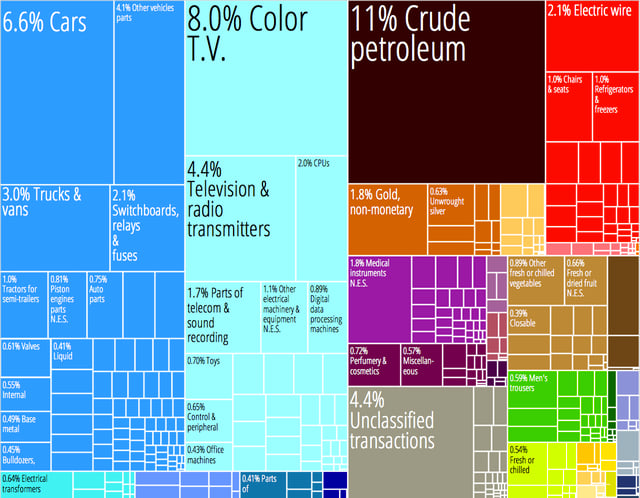
A proportional representation of Mexico's exports.
| Share of world GDP (PPP)[235] | |
|---|---|
| Year | Share |
| 1980 | 3.06% |
| 1990 | 2.68% |
| 2000 | 2.53% |
| 2010 | 2.02% |
| 2017 | 1.94% |
As of April 2018, Mexico has the 15th largest nominal GDP (US$1.15 trillion)[236] and the 11th largest by purchasing power parity (US$2.45 trillion). GDP annual average growth was 2.9% in 2016 and 2% in 2017.[236] Agriculture has comprised 4% of the economy over the last two decades, while industry contributes 33% (mostly automotive, oil, and electronics) and services (notably financial services and tourism) contribute 63%.[236] Mexico's GDP in PPP per capita was US$18,714.05. The World Bank reported in 2009 that the country's Gross National Income in market exchange rates was the second highest in Latin America, after Brazil at US$1,830.392 billion,[237] which led to the highest income per capita in the region at $15,311.[238][239] Mexico is now firmly established as an upper middle-income country. After the slowdown of 2001 the country has recovered and has grown 4.2, 3.0 and 4.8 percent in 2004, 2005 and 2006,[240] even though it is considered to be well below Mexico's potential growth.[241] The International Monetary Fund predicts growth rates of 2.3% and 2.7% for 2018 and 2019, respectively.[236]
Although multiple international organizations coincide and classify Mexico as an upper middle income country, or a middle class country [242][243] Mexico's National Council for the Evaluation of Social Development Policy (CONEVAL), which is the organization in charge to measure the country's poverty reports that a huge percentage of Mexico's population lives in poverty. According to said council, from 2006 to 2010 (year on which the CONEVAL published its first nationwide report of poverty) the portion of Mexicans who live in poverty rose from 18%-19%[244] to 46% (52 million people).[245] However, rather than Mexico's economy crashing, international economists attribute the huge increase in the percentage of population living below the country's poverty line to the CONEVAL using new standards to define it, as now besides people who lives below the economic welfare line, people who lacks at least one "social need" such as complete education, access to healthcare, access to regular food, housing services and goods, social security etc. were considered to be living in poverty (several countries do collect information regarding the persistence of said vulnerabilities on their population, but Mexico is the only one that classifies people lacking one or more of those needs as living below its national poverty line). Said economists do point out that the percentage of people living in poverty according to Mexico's national poverty line is around 40 times higher than the one reported by the World Bank's international poverty line (with said difference being the biggest in the world) and ponder if it wouldn't be better for countries in the situation of Mexico to adopt internationalized standards to measure poverty so the numbers obtained could be used to make accurate international comparisons.[246] According to the OECD's own poverty line (defined as the percentage of a country's population who earns 60%[247] or less of the national median income) 20% of Mexico's population lives in a situation of poverty.[248]
Among the OECD countries, Mexico has the second-highest degree of economic disparity between the extremely poor and extremely rich, after Chile – although it has been falling over the last decade, being one of few countries in which this is the case.[249] The bottom ten percent in the income hierarchy disposes of 1.36% of the country's resources, whereas the upper ten percent dispose of almost 36%. The OECD also notes that Mexico's budgeted expenses for poverty alleviation and social development is only about a third of the OECD average.[250] This is also reflected by the fact that infant mortality in Mexico is three times higher than the average among OECD nations whereas its literacy levels are in the median range of OECD nations. Nevertheless, according to Goldman Sachs, by 2050 Mexico will have the 5th largest economy in the world.[251]
The electronics industry of Mexico has grown enormously within the last decade.
Mexico has the sixth largest electronics industry in the world after China, United States, Japan, South Korea, and Taiwan. Mexico is the second-largest exporter of electronics to the United States where it exported $71.4 billion worth of electronics in 2011.[254] The Mexican electronics industry is dominated by the manufacture and OEM design of televisions, displays, computers, mobile phones, circuit boards, semiconductors, electronic appliances, communications equipment and LCD modules. The Mexican electronics industry grew 20% between 2010 and 2011, up from its constant growth rate of 17% between 2003 and 2009.[254] Currently electronics represent 30% of Mexico's exports.[254]
Mexico produces the most automobiles of any North American nation.[255] The industry produces technologically complex components and engages in some research and development activities.[256] The "Big Three" (General Motors, Ford and Chrysler) have been operating in Mexico since the 1930s, while Volkswagen and Nissan built their plants in the 1960s.[241] In Puebla alone, 70 industrial part-makers cluster around Volkswagen.[256] In the 2010s expansion of the sector was surging. In 2014 alone, more than $10 billion in investment was committed. In September 2016 Kia motors opened a $1 billion factory in Nuevo León,[258] with Audi also opening an assembling plant in Puebla the same year.[259] BMW, Mercedes-Benz and Nissan currently have plants in constructuion.[260]
The domestic car industry is represented by DINA S.A., which has built buses and trucks since 1962,[261] and the new Mastretta company that builds the high-performance Mastretta MXT sports car.[262] In 2006, trade with the United States and Canada accounted for almost 50% of Mexico's exports and 45% of its imports.[14] During the first three quarters of 2010, the United States had a $46.0 billion trade deficit with Mexico.[263] In August 2010 Mexico surpassed France to become the 9th largest holder of US debt.[264] The commercial and financial dependence on the US is a cause for concern.[265]
The remittances from Mexican citizens working in the United States account for 0.2% of Mexico's GDP[266] which was equal to US$20 billion per year in 2004 and is the tenth largest source of foreign income after oil, industrial exports, manufactured goods, electronics, heavy industry, automobiles, construction, food, banking and financial services.[267] According to Mexico's central bank, remittances in 2008 amounted to $25bn.[268]
Communications
The telecommunications industry is mostly dominated by Telmex (Teléfonos de México), privatized in 1990. By 2006, Telmex had expanded its operations to Colombia, Peru, Chile, Argentina, Brazil, Uruguay, and the United States. Other players in the domestic industry are Axtel, Maxcom, Alestra, Marcatel, AT&T Mexico.[271] Because of Mexican orography, providing a landline telephone service at remote mountainous areas is expensive, and the penetration of line-phones per capita is low compared to other Latin American countries, at 40 percent; however, 82% of Mexicans over the age of 14 own a mobile phone. Mobile telephony has the advantage of reaching all areas at a lower cost, and the total number of mobile lines is almost two times that of landlines, with an estimation of 63 million lines.[272] The telecommunication industry is regulated by the government through Cofetel (Comisión Federal de Telecomunicaciones).
The Mexican satellite system is domestic and operates 120 earth stations.
There is also extensive microwave radio relay network and considerable use of fiber-optic and coaxial cable.[272] Mexican satellites are operated by Satélites Mexicanos (Satmex), a private company, leader in Latin America and servicing both North and South America.[273] It offers broadcast, telephone and telecommunication services to 37 countries in the Americas, from Canada to Argentina. Through business partnerships Satmex provides high-speed connectivity to ISPs and Digital Broadcast Services.[274] Satmex maintains its own satellite fleet with most of the fleet being designed and built in Mexico.
Energy
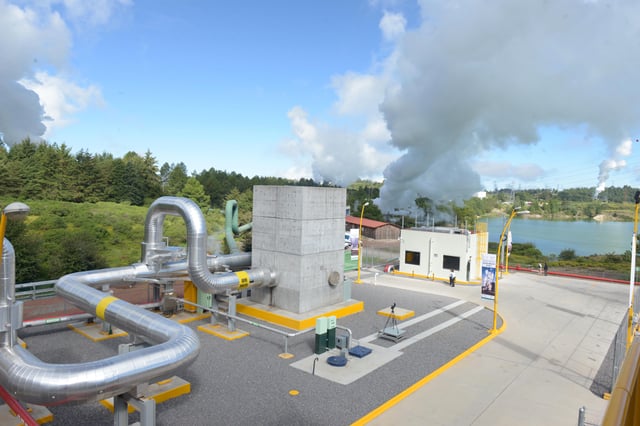
The Central Geotermoeléctrica Azufres III in Michoacán.
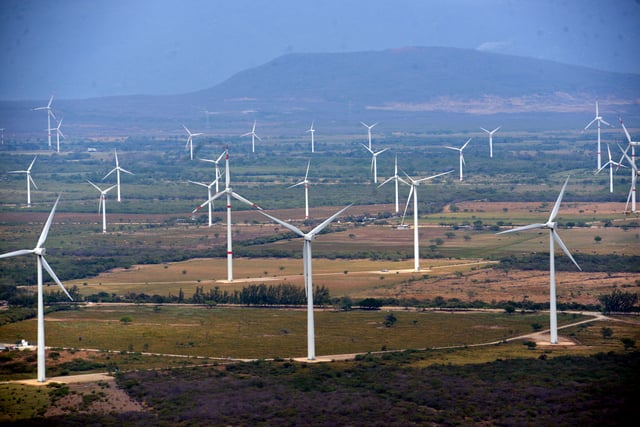
The Central Eólica Sureste I, Fase II in Oaxaca.
Energy production in Mexico is managed by the state-owned companies Federal Commission of Electricity and Pemex.
Pemex, the public company in charge of exploration, extraction, transportation and marketing of crude oil and natural gas, as well as the refining and distribution of petroleum products and petrochemicals, is one of the largest companies in the world by revenue, making US$86 billion in sales a year.[277][278][279] Mexico is the sixth-largest oil producer in the world, with 3.7 million barrels per day.[280] In 1980 oil exports accounted for 61.6% of total exports; by 2000 it was only 7.3%.[256]
The largest hydro plant in Mexico is the 2,400 MW Manuel Moreno Torres Dam in Chicoasén, Chiapas, in the Grijalva River. This is the world's fourth most productive hydroelectric plant.[281]
Mexico is the country with the world's third largest solar potential.[282] The country's gross solar potential is estimated at 5kWh/m2 daily, which corresponds to 50 times national electricity generation.[283] Currently, there is over 1 million square meters of solar thermal panels[284] installed in Mexico, while in 2005, there were 115,000 square meters of solar PV (photo-voltaic). It is expected that in 2012 there will be 1,8 million square meters of installed solar thermal panels.[284]
The project named SEGH-CFE 1, located in Puerto Libertad, Sonora, Northwest of Mexico, will have capacity of 46.8 MW from an array of 187,200 solar panels when complete in 2013.[285] All of the electricity will be sold directly to the CFE and absorbed into the utility's transmission system for distribution throughout their existing network. At an installed capacity of 46.8 MWp, when complete in 2013, the project will be the first utility scale project of its kind in Mexico and the largest solar project of any kind in Latin America.
Science and technology
The National Autonomous University of Mexico was officially established in 1910,[286] and the university became one of the most important institutes of higher learning in Mexico.[287] UNAM provides world class education in science, medicine, and engineering.[288] Many scientific institutes and new institutes of higher learning, such as National Polytechnic Institute (founded in 1936),[289] were established during the first half of the 20th century. Most of the new research institutes were created within UNAM. Twelve institutes were integrated into UNAM from 1929 to 1973.[290] In 1959, the Mexican Academy of Sciences was created to coordinate scientific efforts between academics.
In 1995, the Mexican chemist Mario J. Molina shared the Nobel Prize in Chemistry with Paul J. Crutzen and F. Sherwood Rowland for their work in atmospheric chemistry, particularly concerning the formation and decomposition of ozone.[291] Molina, an alumnus of UNAM, became the first Mexican citizen to win the Nobel Prize in science.[292]
In recent years, the largest scientific project being developed in Mexico was the construction of the Large Millimeter Telescope (Gran Telescopio Milimétrico, GMT), the world's largest and most sensitive single-aperture telescope in its frequency range.[293] It was designed to observe regions of space obscured by stellar dust.
Tourism
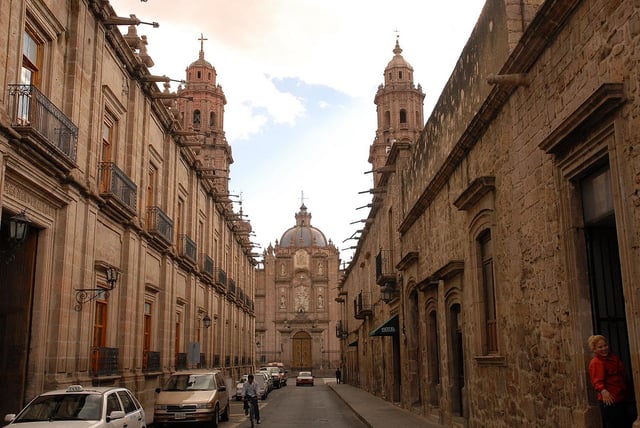
Street in the historic center of Morelia. Mexico has historical architecture in most of its towns being the country with the highest number of Colonial buildings and structures in all of the Americas and also placing a vast number of Pre-colonial landmarks.
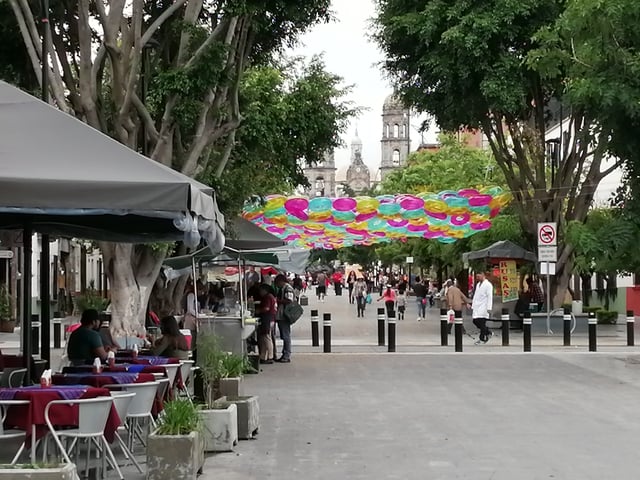
November 20th Way in Zapopan, Jalisco
Mexico has traditionally been among the most visited countries in the world according to the World Tourism Organization and it is the most visited country in the Americas after the United States. The most notable attractions are the Mesoamerican ruins, cultural festivals, colonial cities, nature reserves and the beach resorts. The nation's wide range of climates, from temperate to tropical, and unique culture – a fusion of the European and the Mesoamerican – make Mexico an attractive destination. The peak tourism seasons in the country are during December and the mid-Summer, with brief surges during the week before Easter and Spring break, when many of the beach resort sites become popular destinations for college students from the United States.
As of 2017, Mexico was the 6th most visited country in the world and had the 15th highest income from tourism in the world which is also the highest in Latin America.[294] The vast majority of tourists come to Mexico from the United States and Canada followed by Europe and Asia.
A smaller number also come from other Latin American countries.[295] In the 2017 Travel and Tourism Competitiveness Report, Mexico was ranked 22nd in the world, which was 3rd in the Americas.[296]
The coastlines of Mexico harbor many stretches of beaches that are frequented by sunbathers and other visitors.
According to national law, the entirety of the coastlines are under federal ownership, that is, all beaches in the country are public. On the Yucatán peninsula, one of the most popular beach destinations is the resort town of Cancún, especially among university students during spring break. Just offshore is the beach island of Isla Mujeres, and to the east is the Isla Holbox. To the south of Cancun is the coastal strip called Riviera Maya which includes the beach town of Playa del Carmen and the ecological parks of Xcaret and Xel-Há. A day trip to the south of Cancún is the historic port of Tulum. In addition to its beaches, the town of Tulum is notable for its cliff-side Mayan ruins.
On the Pacific coast is the notable tourist destination of Acapulco. Once the destination for the rich and famous, the beaches have become crowded and the shores are now home to many multi-story hotels and vendors. Acapulco is home to renowned cliff divers: trained divers who leap from the side of a vertical cliff into the surf below.
At the southern tip of the Baja California peninsula is the resort town of Cabo San Lucas, a town noted for its beaches and marlin fishing.[297] Further north along the Sea of Cortés is the Bahía de La Concepción, another beach town known for its sports fishing. Closer to the United States border is the weekend draw of San Felipe, Baja California.
Transportation
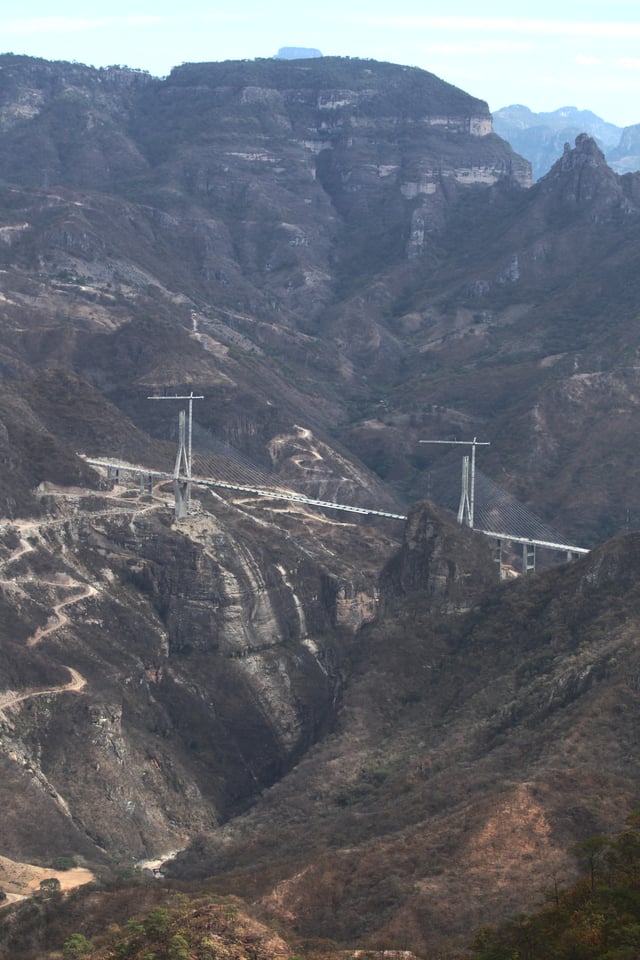
The Baluarte Bridge is the highest cable-stayed bridge in the world, the fifth-highest bridge overall and the highest bridge in the Americas.
The roadway network in Mexico is extensive and all areas in the country are covered by it.[298] The roadway network in Mexico has an extent of 366,095 km (227,481 mi),[14] of which 116,802 km (72,577 mi) are paved,[300] making it the largest paved-roadway network in Latin America.[301] Of these, 10,474 km (6,508 mi) are multi-lane expressways: 9,544 km (5,930 mi) are four-lane highways and the rest have 6 or more lanes.[300]
Mexico was one of the first Latin American countries to promote railway development,[176] and the network covers 30,952 km (19,233 mi).[298] The Secretary of Communications and Transport of Mexico proposed a high-speed rail link that will transport its passengers from Mexico City to Guadalajara, Jalisco.[303][304] The train, which will travel at 300 kilometres per hour (190 miles per hour),[305] will allow passengers to travel from Mexico City to Guadalajara in just 2 hours.[305] The whole project was projected to cost 240 billion pesos, or about 25 billion US$[303] and is being paid for jointly by the Mexican government and the local private sector including the wealthiest man in the world, Mexico's billionaire business tycoon Carlos Slim.[306] The government of the state of Yucatán is also funding the construction of a high speed line connecting the cities of Cozumel to Mérida and Chichen Itza and Cancún.[307]
Water supply and sanitation
Among the achievements is a significant increase in access to piped water supply in urban areas (88% to 93%) as well as in rural areas (50% to 74%) between 1990 and 2010.
Additionally, a strong nationwide increase in access to improved sanitation (64% to 85%) was observed in the same period. Other achievements include the existence of a functioning national system to finance water and sanitation infrastructure with a National Water Commission as its apex institution; and the existence of a few well-performing utilities such as Aguas y Drenaje de Monterrey.
The challenges include water scarcity in the northern and central parts of the country; inadequate water service quality (drinking water quality; 11% of Mexicans receiving water only intermittently as of 2014);[310] poor technical and commercial efficiency of most utilities (with an average level of non-revenue water of 43.2% in 2010);[311] an insufficient share of wastewater receiving treatment (36% in 2006); and still inadequate access in rural areas. In addition to on-going investments to expand access, the government has embarked on a large investment program to improve wastewater treatment.
Demographics

Population pyramid 2017
| Historical population | ||
|---|---|---|
| Year | Pop. | ±% |
| 1910 | 15,160,369 | — |
| 1921 | 14,334,780 | −5.4% |
| 1940 | 19,653,552 | +37.1% |
| 1960 | 34,923,129 | +77.7% |
| 1980 | 66,846,833 | +91.4% |
| 2000 | 97,483,412 | +45.8% |
| 2015 | 121,005,816 | +24.1% |
| Source:INEGI | ||
Throughout the 19th century, the population of Mexico had barely doubled.
This trend continued during the first two decades of the 20th century, and even in the 1920 census there was a loss of about 2 million inhabitants.
The phenomenon can be explained because during the decade from 1910 to 1920 the Mexican Revolution took place.
The growth rate increased dramatically between the 1930s and the 1980s, when the country registered growth rates of over 3% (1950–1980).
The Mexican population doubled in twenty years, and at that rate it was expected that by the year 2000 there would be 120 million Mexicans.
Life expectancy went from 36 years (in 1895) to 72 years (in the year 2000).
According to estimations made by Mexico's National Geography and Statistics Institute, as of 2017 Mexico has 123.5 million inhabitants[312] making it the most populous Spanish-speaking country in the world.[313] Between 2005 and 2010, the Mexican population grew at an average of 1.70% per year, up from 1.16% per year between 2000 and 2005.
Even though Mexico is a very ethnically diverse country, research about ethnicity has largely been a forgotten field, in consequence of the post-revolutionary efforts of Mexico's government to unify all non-indigenous Mexicans under a single ethnic identity (that of the "Mestizo").
As a result, since 1930 the only explicit ethnic classification that has been included in Mexican censuses has been that of "Indigenous peoples".[314] Even then, across the years the government has used different criteria to count Indigenous peoples, with each of them returning considerably different numbers.
It is not until very recently that the Mexican government begun conducting surveys that considered the Afro-Mexican and Euro-Mexican population that lives in the country.
As of 2017, it is estimated that 1.2 million foreigners have settled in the country,[315] up from nearly 1 million in 2010.[316] The vast majority of migrants come from the United States (900,000), making Mexico the top destination for U.S. citizens abroad.[317] The second largest group comes from neighboring Guatemala (54,500), followed by Spain (27,600).[315] Other major sources of migration are fellow Latin American countries, which include Colombia (20,600), Argentina (19,200) and Cuba (18,100).[315] Historically, the Lebanese diaspora and the German-born Mennonite migration have left a notorious impact in the country's culture, particularly in its cuisine and traditional music.[318][319] At the turn of the 21st century, several trends have increased the number of foreigners residing in the country such as the 2008–2014 Spanish financial crisis,[320] increasing gang-related violence in the Northern Triangle of Central America,[321] the ongoing political and economic crisis in Venezuela,[322][323] and the automotive industry boom led by Japanese and South Korean investment.[324][325]
Ethnicity and race
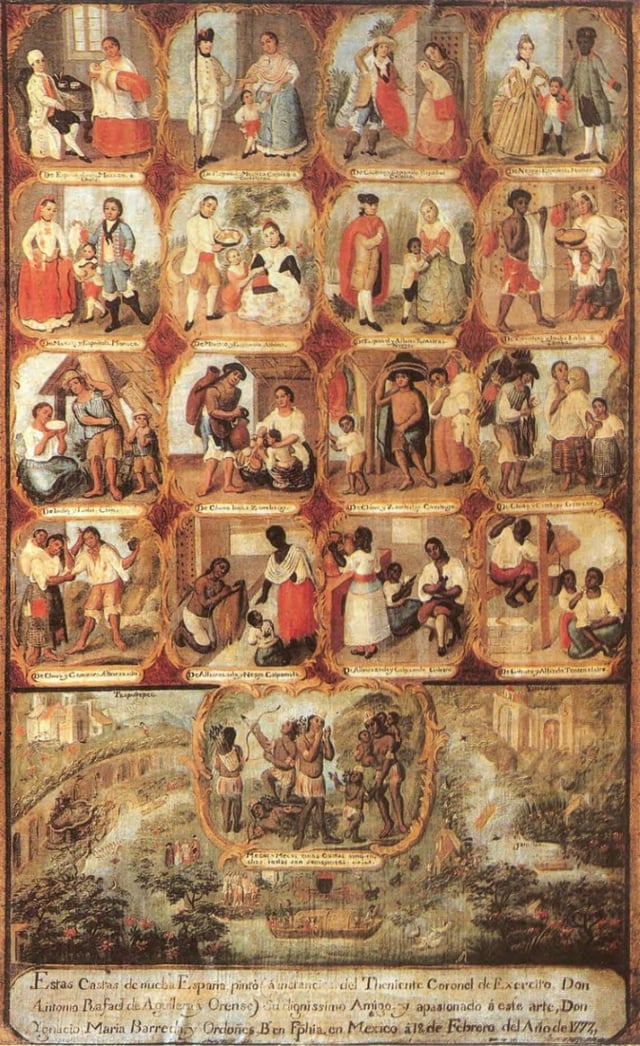
Depiction of the casta system in Mexico. Painting of 1777.
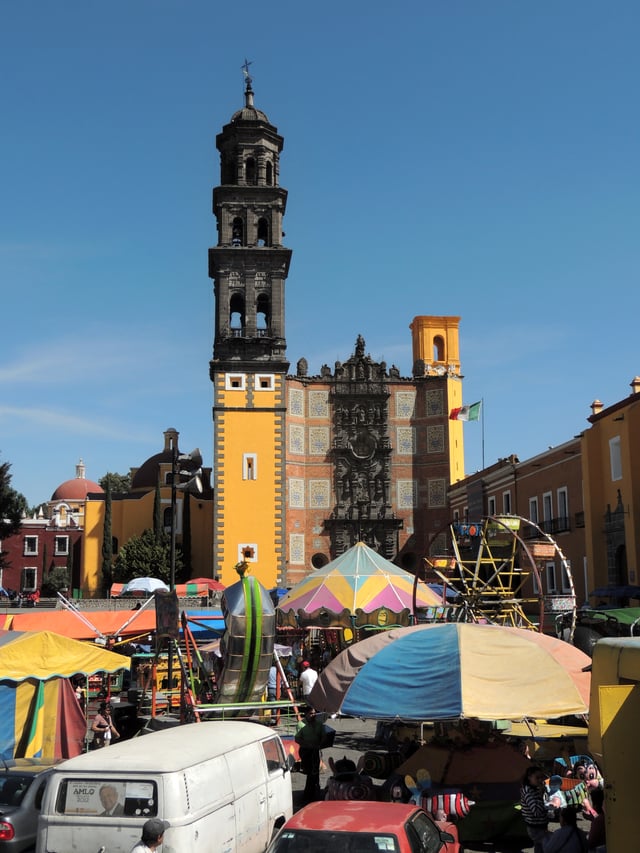
Puebla de Zaragoza is the most populated city of Puebla
Mexico is ethnically diverse; with people of several ethnicities being united under a single national identity.[326] The core part of Mexican national identity is formed on the basis of a synthesis of cultures, primarily European culture and indigenous cultures, in a process known as mestizaje.[326] Manuel Gamio ental in building a Mexican national identity on the concept of mestizaje.[328]
The large majority of Mexicans have historically been classified as "Mestizos". In modern Mexican usage, the term mestizo is primarily a cultural identity rather than the racial identity it was during the colonial era, resulting in individuals with varying phenotypes being classified under the same identity, regardless of whether they are of mixed ancestry or not.[329] In the Yucatán Peninsula the word Mestizo has a different meaning, being used to refer to the Maya-speaking populations living in traditional communities, because during the Caste War of the late 19th century those Maya who did not join the rebellion were classified as mestizos.[330] In Chiapas the word Ladino is used instead of mestizo.[331] Due the different definitions and socio-cultural connotations the term has carried through history it was deemed too imprecise to be used for ethnic classification, which led to it being abandoned by the government and the Mexican society,[176][332] with its use being limited to intellectual circles. According to the Mexican census of 1921 and publications who retake its results such as Encyclopædia Britannica, the majority of Mexicans (from 50% to 67% of the country's population) identify as Mestizo,[333] although modern research has observed that when asked directly about their ethno-racial identification, many Mexicans do not identify as Mestizos.[334]
The total percentage of Mexico's population who are indigenous varies considerably depending of the criteria used by the government on its censuses: it is 5.4% if the ability to speak an indigenous language is used as the criteria to define a person as indigenous,[335] if racial self-identification is used it is 14.9%[336][1] and if people who consider themselves part indigenous are also included it amounts to 23%.[339] Nonetheless, all the censuses conclude that the majority of Mexico's indigenous population is concentrated in rural areas of the southern and south-eastern Mexican states such as[340] Yucatán at 59%, Quintana Roo 39% and Campeche 27%, who are chiefly Maya; Oaxaca with 48% of the population, the most numerous groups being the Mixtec and Zapotec peoples; Chiapas at 28%, the majority being Tzeltal and Tzotzil Maya; Hidalgo 24%, the majority being Otomi; Puebla 19%, and Guerrero 17%, mostly Nahua peoples and the states of San Luis Potosí and Veracruz are both home to a population that is 15% indigenous, mostly from the Totonac, Nahua and Teenek (Huastec) groups.[341] The absolute numbers of the indigenous population are growing, but at a slower rate than the rest of the population so that the percentage of indigenous peoples in regards to total population is nonetheless falling.[342] All of the indices of social development for the indigenous population are considerably lower than the national average even though the indigenous population participates in the workforce longer than the national average with 55% of the indigenous population receiving less than a minimum salary, compared to 20% for the national average. Many practice subsistence agriculture and regulate some internal issues under customary law.[341]
Similarly to Mestizo and indigenous peoples, estimates of the percentage of European-descended Mexicans within the Mexican population vary considerably: according to the Encyclopædia Britannica which uses as reference the 1921 census their numbers range from around 10%–20%.[333] (the results of the 1921 census, however, have been contested by various historians and deemed inaccurate).[343] Recent nationwide field surveys that account for different phenotypical traits (hair color, skin color etc.) on the other hand, report rather higher percentages, with it being between 18%[344]-23%[345] if the criteria is the presence of blond hair, and of 47% if the criteria is skin color, with the later surveys having been conducted by Mexico's government with the aim to address ethnic and racial discrimination in the country.[346][347][348][349][350] While during the colonial era, most of the European migration into Mexico was Spanish, in the 19th and 20th centuries a substantial number of non-Spanish Europeans immigrated to the country. According to 20th- and 21st-century academics, large scale intermixing between European immigrants and native Indigenous peoples would produce a Mestizo group which would become the overwhelming majority of Mexico's population by the time of the Mexican Revolution.[351] However, according to church registers from the colonial times, the majority of European men married European women.[343] Said registers also put in question other narratives held by contemporary academics, such as European migrants who arrived in Mexico being almost exclusively men,[352] or that "pure Spanish" people were all part of a small powerful elite, as Spaniards were often the most numerous ethnic group in the colonial cities[353] and there were menial workers and people in poverty who were of complete Spanish origin.[352] Nowadays Mexico's northern and western regions have the highest European populations, with the majority of the people not having native admixture or being of predominantly European ancestry.[354]
The Afro-Mexican population (1,381,853 individuals as of 2015)[355] is an ethnic group made up of descendants of Colonial-era slaves and recent immigrants of sub-Saharan African descent.
Mexico had an active slave trade during the colonial period, and some 200,000 Africans were taken there, primarily in the 17th century.
The creation of a national Mexican identity, especially after the Mexican Revolution, emphasized Mexico's indigenous and European past; it passively eliminated the African ancestors and contributions.
Most of the African-descended population was absorbed into the surrounding Mestizo (mixed European/indigenous) and indigenous populations through unions among the groups.
Evidence of this long history of intermarriage with Mestizo and indigenous Mexicans is also expressed in the fact that in the 2015 inter-census, 64.9% (896,829) of Afro-Mexicans also identified as indigenous.
It was also reported that 9.3% of Afro-Mexicans speak an indigenous language.[355] The states with the highest self-report of Afro-Mexicans were Guerrero (6.5% of the population), Oaxaca (4.95%) and Veracruz (3.28%).[357] Afro-Mexican culture is strongest in the communities of the Costa Chica of Oaxaca and Costa Chica of Guerrero.
During the early 20th century, a substantial number of Arabs (mostly Christians)[358] began arriving from the crumbling Ottoman Empire. The largest group were the Lebanese and an estimated 400,000 Mexicans have some Lebanese ancestry.[359] Smaller ethnic groups in Mexico include South and East Asians, present since the colonial era. During the colonial era Asians were termed Chino (regardless of ethnicity), and arrived as merchants, artisans and slaves.[360] A study by Juan Esteban Rodríguez, a graduate student at the National Laboratory of Genomics for Biodiversity, indicated that up to one third of people sampled from Guerrero state had significantly more Asian ancestry than most Mexicans, primarily Filipino or Indonesian.[361][362] Modern Asian immigration began in the late 19th century, and at one point in the early 20th century the Chinese were the second largest immigrant group.[363]
Official censuses
The first census in Mexico (then known as New Spain) that included an ethnic classification was the 1793 census. Also known as the Revillagigedo census. Most of its original datasets have reportedly been lost, thus most of what is known about it nowadays comes from essays and field investigations made by academics who had access to the census data and used it as reference for their works such as Prussian geographer Alexander von Humboldt. According to said works Europeans ranged from 18% to 22% of New Spain's population, Mestizos from 21% to 25%, Indians from 51% to 61% and Africans were between 6,000 and 10,000. The total population ranged from 3,799,561 to 6,122,354. It is concluded that the population growth trends of whites and mestizos were even, while the percentage of the indigenous population decreased at a rate of 13%–17% per century mostly due the later having higher mortality rates for living in remote locations and being in constant war with the colonists.[364] Anthropologist Gonzalo Aguirre Beltrán goes beyond said numbers and splits the Mestizo group into "Euromestizos", "Indomestizos" and "Afromestizos" calculating their numbers at more than one million, 700,000 and 600,000 respectively.[365] Independent-era Mexico eliminated the legal basis of the Colonial caste system which led to exclusion of racial classification in the censuses to come.
According to Mexico's second census ever that considered race, made right after the Mexican revolution in 1921,[366] 59% of Mexico's population was Mestizo, 29% was Indigenous and only 9% was European, with Mestizos being the most numerous ethno-racial group in almost all the states.[366] For a long time this census' results were taken as fact, with extraofficial international publications such as The World Factbook and Encyclopædia Britannica using them as a reference to estimate Mexico's racial composition up to this day.[14][333] In recent time nonetheless, Mexican academics have subjected the census' results to scrutiny, claiming that such a drastic alteration in demographic trends in regards to the 1793 census is not possible and cite, among other statistics the relatively low frequency of marriages between people of different continental ancestries in colonial and early independent Mexico.[368][343] Said authors claim that the Mexican society went through a "more cultural than biological mestizaje process" sponsored by the state in its efforts to unify the Mexican population which resulted in the inflation of the percentage of the Mestizo Mexican group at the expense of the identity of the other races that exist in Mexico.[369]
In recent times the Mexican government has decided to conduct new ethnic surveys and censuses, also widening the criteria to classify the ethnicities who were already considered such as the Indigenous Mexican one, which was previously reserved to people who lived in indigenous communities or spoke an indigenous language.
According to these recent surveys, Indigenous peoples amount to 23% of Mexico's population (including people who declared to be partially indigenous),[339] Afro-Mexicans are 2% of Mexico's population (including people who declared to be partially African)[339] and White or European Mexicans amount to 47% of Mexico's population (based on appearance rather than on self-declared of ancestry).[346][347][348][370] Less numerous groups in Mexico such as Asians and Middle Easterners are also accounted for. Out of all the ethnic groups that have recently been surveyed, that of Mestizos is notably absent, which may be consequence of the ethnic label's fluid and subjective definition, which complicates a precise calculation as well the tendency that Mexicans have to identify people with "static" ethnic labels rather than "fluid" ones.[371]
Emigration
In the early 1960s, around 600,000 Mexicans lived abroad, which increased sevenfold by the 1990s to 4.4 million.[372] At the turn of the 21st century, this figure more than doubled to 9.5 million.[372] As of 2017, it is estimated that 12.9 million Mexicans live abroad, primarily in the United States, which concentrates nearly 98% of the expatriate population.[372] The majority of Mexicans have settled in states such as California, Texas and Illinois, particularly around the metropolitan areas of Los Angeles, Chicago, Houston and Dallas-Fort Worth.[373] As a result of these major migration flows in recent decades, around 36 million U.S. residents, or 11.2% of the country's population, identified as being of full or partial Mexican ancestry.[374] The remaining 2% of expatriates have settled in Canada (86,000), primarily in the provinces of Ontario and Quebec,[375] followed by Spain (49,000) and Germany (18,000), both European destinations represent almost two-thirds of the Mexican population living in the continent.[372] As for Latin America, it is estimated that 69,000 Mexicans live in the region, Guatemala (18,000) being the top destination for expatriates, followed by Bolivia (10,000) and Panama (5,000).[372]
Languages
Spanish is the de facto national language spoken by the vast majority of the population, making Mexico the world's most populous Hispanophone country.[376][313] Mexican Spanish is the set of varieties of the language spoken in the country, which differs from one region to another phonetically, syntactically and lexically.[377] In general, Mexican Spanish does not make any phonetic distinction among the letters s and z, as well as c when preceding the vowels e and ias opposed to Peninsular Spanish. The letters b and vave the same pronunciation as well.[377] Furthermore, the usage of vos, the second person singular pronoun, found in several Latin American varieties, is replaced by tú; whereas vosotros, the second person plural pronoun, fell out of use and was effectively replaced by ustedes.[377] In written form, the Spanish Royal Academy serves as the primary guideline for spelling, except for words of Amerindian origin that retain their original phonology such as cenzontle instead of sinzontle and México not Méjico*]]. Words of foreign origin also maintain their original spelling such as whisky and film, as opposed to* squi* and filmeas the Royal Academy suggests.[377] The letter* xis distinctly used in Mexican Spanish, which may be pronounced as [ks] (as in oxígenoor taxi*), as [ʃ] particularly in Amerindian words (e.g.* mixiote*,* Xola* and uxmal Texas and Oaxaca).[377]
The federal government officially recognizes sixty-eight linguistic groups and 364 varieties of indigenous languages.[378] It is estimated that around 8.3 million citizens speak these languages,[379] with Nahuatl being the most widely spoken by more than 1.7 million, followed by Yucatec Maya used daily by nearly 850,000 people, Tzeltal and Tzotzil, two variants of the Mayan languages, are spoken by around half a million people each, primarily in the southern state of Chiapas.[379] Mixtec and Zapotec, both with estimated 500,000 native speakers each, are two other notorious language groups.[379] Since its creation in March 2003, the National Indigenous Languages Institute has been in charge of promoting and protecting the use of the country's indigenous languages, through the General Law of Indigenous Peoples' Linguistic Rights, which recognizes them de jure as "national languages" with equal status as that of Spanish.[380] Notwithstanding, in practice, indigenous peoples often face discrimination and are unable to have proper access to public services such as education and healthcare, as well as the justice system, as Spanish is the prominent language.[381]
Aside from indigenous languages, there are several minority languages spoken in Mexico due to international migration such as Low German by the 80,000-strong Menonite population, primarily settled in the northern states, fuelled by the tolerance of the federal government towards this community by allowing them to set their own educational system compatible with their customs and traditions.[382] The Chipilo dialect, a variance of the Venetian language, is spoken in the town of Chipilo, located in the central state of Puebla, by around 2,500 people, mainly descendants of Venetians that migrated to the area in the late 19th century.[383] Furthermore, English is the most commonly taught foreign language in Mexico. It is estimated that nearly 24 million, or around a fifth of the population, study the language through public schools, private institutions or self-access channels.[384] However, a high level of English proficiency is limited to only 5% of the population.[385] Moreover, French is the second most widely taught foreign language, as every year between 200,000 and 250,000 Mexican students enroll in language courses.[386][387][388]
Urban areas
Here are the 20 largest urban areas in Mexico.
Religion
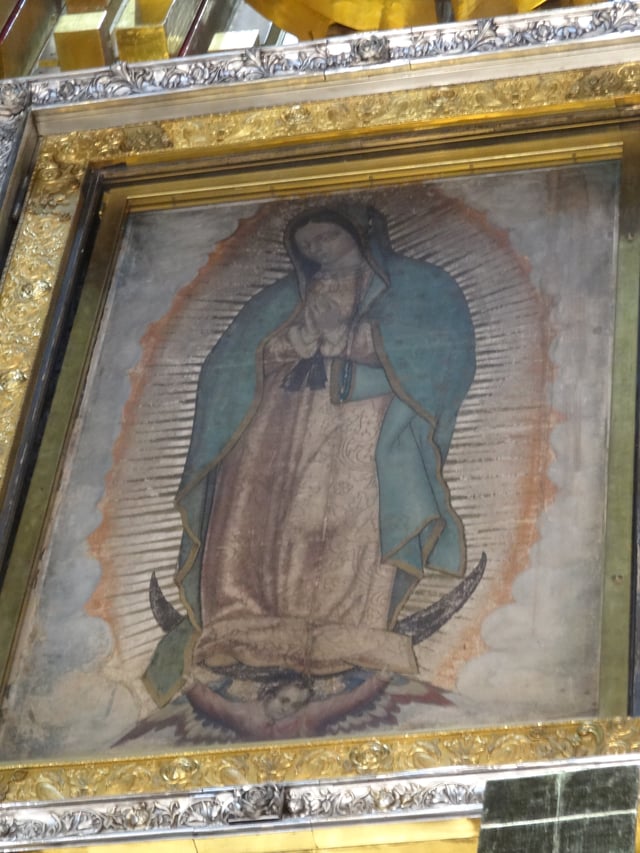
Our Lady of Guadalupe, patron saint of Mexico, an ancient Marian title of Amerindian race. This painting of her at the Basilica of Guadalupe is among her most notable depictions; scientists still debate if it should be dated 1531, the year of the first apparition,[390] or the 1550s.[391]
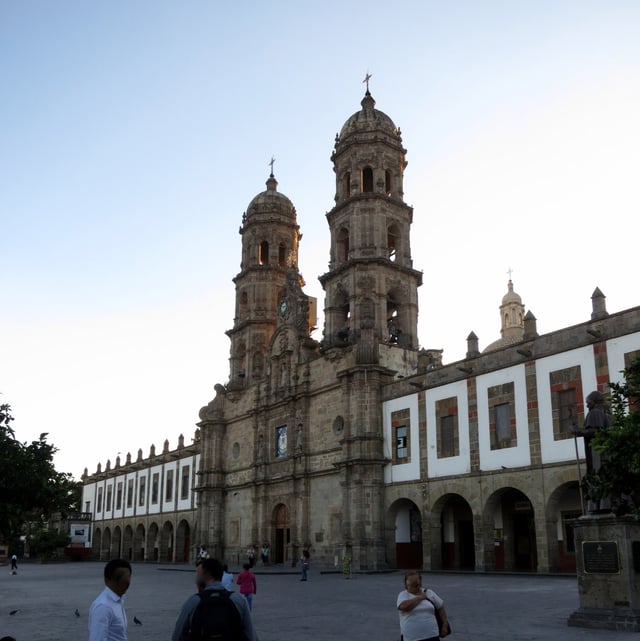
Basilica of Our Lady of Zapopan in Zapopan, Jalisco
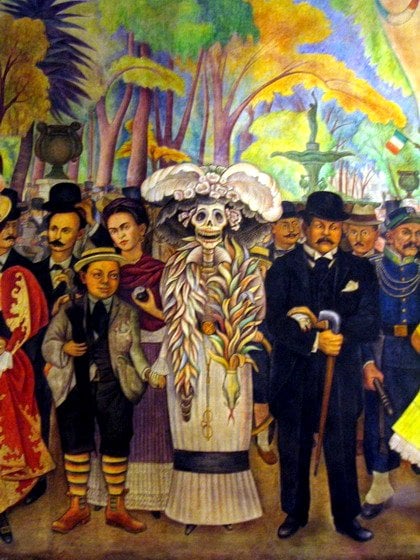
Detail of the 1947 Rivera mural, Dream of a Sunday Afternoon in the Alameda Central. The mural includes a depiction of La Catrina, a popular satirical character that has become associated with Día de Muertos.
The 2010 census by the Instituto Nacional de Estadística y Geografía (National Institute of Statistics and Geography) gave Roman Catholicism as the main religion, with 83% of the population, while 10% (10,924,103) belong to other Christian denominations, including Evangelicals (5%); Pentecostals (1.6%); other Protestant or Reformed (0.7%); Jehovah's Witnesses (1.4%); Seventh-day Adventists (0.6%); and members of The Church of Jesus Christ of Latter-day Saints (0.3%).[2] 172,891 (or less than 0.2% of the total) belonged to other, non-Christian religions; 4.7% declared having no religion; 2.7% were unspecified.[2]
The 92,924,489[2] Catholics of Mexico constitute in absolute terms the second largest Catholic community in the world, after Brazil's.[392] 47% percent of them attend church services weekly.[393] The feast day of Our Lady of Guadalupe, the patron saint of Mexico, is celebrated on December 12 and is regarded by many Mexicans as the most important religious holiday of their country.[394] In spite of this, the Mexican State is officially lay secularist since the separation between religious institutions and the political administration of the nation was enshrined in the 1857, and was ratified in the current Constitution of 1917. José María Morelos noted in his writings that there should be no tolerance for any other religion and the Constitution of 1824 declared that the official religion of the Republic would be Catholic, and from the second half of the 20th century, began a process of introducing creeds different from the Catholic.
The 1920s was marked by a religious conflict known as the Cristero War, in which many peasants encouraged by the clergy clashed with the federal government that had decided to enforce the constitutional laws of 1917. Among the measures contemplated by the Magna Carta were the suppression of the monastic orders and the cancellation of all religious worship. The war ended with an agreement between the parties in conflict (Catholic Church and State), by means of which the respective fields of action were defined. Until the middle of the 1990s, the Mexican constitution did not recognize the existence of any religious group. In 1993, a law was enacted whereby the State granted them legal status as "religious associations". This fact allowed the reestablishment of diplomatic relations with the Holy See, to which the Mexican State did not recognize as a political entity.
According to the figures of INEGI, most Mexicans declare themselves Christian and most Catholics (almost 93 million adherents according to the census of 2010).[2] The second Christian group is the Jehovah's Witnesses, which totals more than 1 million adherents, making the Mexican congregation of this Christian branch the second worldwide. Thirdly find The Church of Jesus Christ of Latter-day Saints, whose members are known as Mormons, 2010 census reported 314,932 members of The Church of Jesus Christ of Latter-day Saints,[2] though the church in 2009 claimed to have over one million registered members;[395] followed by Church of the La Luz del Mundo, which has its center in "La Hermosa Provincia", a colony of Guadalajara. The denominations Pentecostal also have an important presence, especially in the cities of the border and in the indigenous communities. In fact, Pentecostal churches together have more than 1.3 million adherents, which in net numbers place them as the second Christian creed in Mexico. The situation changes when the different Pentecostal denominations are considered as separate entities. Other groups are growing, such as Iglesia apostólica de la Fe en Cristo Jesús, Mennonites and Seventh-day Adventist Church. Migratory phenomena have led to the proliferation of different aspects of Christianity, including branches Protestants, Eastern Catholic Churches and Eastern Orthodox Church.
According to Jacobo Grinberg-Zylberbaum (in texts edited by the National Autonomous University of Mexico), it is remarkable the survival of magic-religious rituals of the old indigenous groups, not only in the current indigenous people but in the mestizos and whites that make up the Mexican rural and urban society. There is often a syncretism between shamanism and the Catholic tradition. Another religion of popular syncretism in Mexico (especially in recent years) is the Santería. This is mainly due to the large number of Cubans who settled in the territory after the Cuban Revolution (mainly in states such as Veracruz and Yucatán). Although Mexico was also a recipient of black slaves from Africa in the 16th century, the apogee of these cults is relatively new.[396]
In certain regions, the profession of a creed other than the Catholic is seen as a threat to community unity.
It is argued that the Catholic religion is part of the ethnic identity, and that the Protestants are not willing to participate in the traditional customs and practices (the tequio or community work, participation in the festivities and similar issues).
The refusal of the Protestants is because their religious beliefs do not allow them to participate in the cult of images.
In extreme cases, tension between Catholics and Protestants has led to the expulsion or even murder of Protestants in several villages.
The best known cases are those of San Juan Chamula,[397][398] in Chiapas, and San Nicolás, in Ixmiquilpan,[399] Hidalgo.
A similar argument was presented by a committee of anthropologists to request the government of the Republic to expel the Summer Linguistic Institute (SIL), in the year 1979, which was accused of promoting the division of indigenous peoples by translating the Bible into vernacular languages and evangelizing in a Protestant creed that threatened the integrity of popular cultures. The Mexican government paid attention to the call of the anthropologists and canceled the agreement that had held with the SIL. Conflicts have also occurred in other areas of social life. For example, given that Jehovah's Witnesses are prohibited from surrendering honors to national symbols (something that is done every Monday in Mexican public schools), children who have been educated in that religion were expelled from public schools. This type of problem can only be solved with the intervention of the National Commission of Human Rights, and not always with favorable results for children.
The impact of the Catholic religion in Mexico has also caused a fusion of elements.
Beyond churches and religious denominations, a phenomenon persists in Mexico that some anthropologists and sociologists call "popular religion", that is, religion as the practice and understanding of the people.
In Mexico, the main component is the Catholic religion, to which elements of other beliefs have been added, already of pre-Hispanic, African or Asian origin.
In general, popular religiosity is viewed with bad eyes by institutionally structured religions.
One of the most exemplary cases of popular religiosity is the cult of Holy Dead (Santa Muerte). The Catholic hierarchy insists on describing it as a satanic cult. However, most of the people who profess this cult declare themselves to be Catholic believers, and consider that there is no contradiction between the tributes they offer to the Christ Child and the adoration of God. Other examples are the representations of the Passion of Christ and the celebration of Day of the Dead, which take place within the framework of the Catholic Christian imaginary, but under a very particular reinterpretation of its protagonists.
The presence of Jews in Mexico dates back to 1521, when Hernán Cortés conquered the Aztecs, accompanied by several Conversos.[400] According to the 2010 census, there are 67,476 Jews in Mexico.[2] Islam in Mexico is practiced mostly by Arab Mexicans. In the 2010 census 18,185 Mexicans reported belonging to an Eastern religion,[2] a category which includes a tiny Buddhist population.
Women
Until the twentieth century, Mexico was an overwhelmingly rural country, with rural women's status defined within the context of the family and local community.
With urbanization beginning in the sixteenth century, following the Spanish conquest of the Aztec empire, cities have provided economic and social opportunities not possible within rural villages.
As of 2014, Mexico has the 16th highest rate of homicides committed against women in the world.[401] A study in 1997 showed that the prevalence of domestic violence against women in Mexican marital relationships varies at between 30 and 60 percent of relationships.[402] The remains of the victims were frequently mutilated.[403] According to a 1997 study, domestic abuse in Mexican culture "is embedded in gender and marital relations fostered in Mexican women's dependence on their spouses for subsistence and for self-esteem, sustained by ideologies of romantic love, by family structure and residential arrangements".[404] The perpetrators are often the boyfriend, father-in-law, ex-husbands or husbands but only 1.6% of the murder cases led to an arrest and sentencing.[403]
Culture
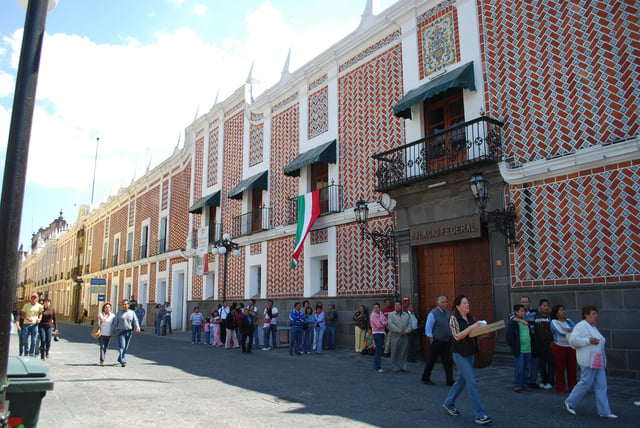
Talavera pottery
Mexican culture reflects the complexity of the country's history through the blending of indigenous cultures and the culture of Spain, imparted during Spain's 300-year occupation of Mexico. Exogenous cultural elements have been incorporated into Mexican culture as time has passed.
The Porfirian era (Porfiriato), in the last quarter of the 19th century and the first decade of the 20th century, was marked by economic progress and peace.
After four decades of civil unrest and war, Mexico saw the development of philosophy and the arts, promoted by President Díaz himself.
Since that time, as accentuated during the Mexican Revolution, cultural identity has had its foundation in the mestizaje, of which the indigenous (i.e. Amerindian) element is the core. In light of the various ethnicities that formed the Mexican people, José Vasconcelos in his publication La Raza Cósmica (The Cosmic Race) (1925) defined Mexico to be the melting pot of all races (thus extending the definition of the mestizo) not only biologically but culturally as well.[405]
Painting
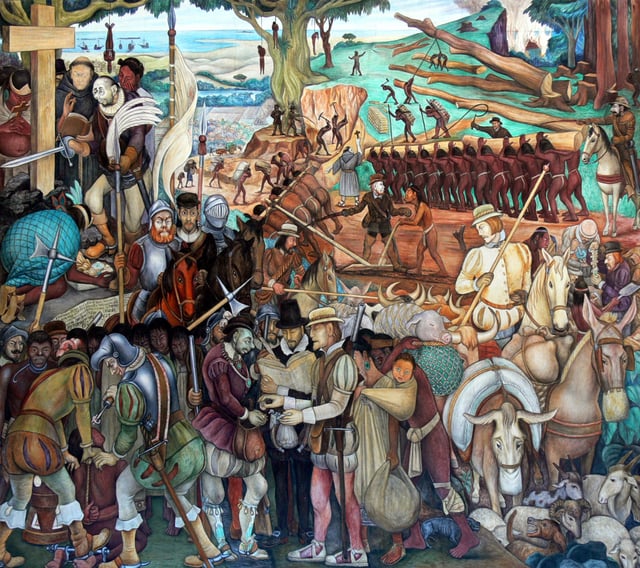
Mexican Muralism. A cultural expression starting in the 1920s created by a group of Mexican painters after the Mexican Revolution, reinforced by the Great Depression and the First World War.[406]
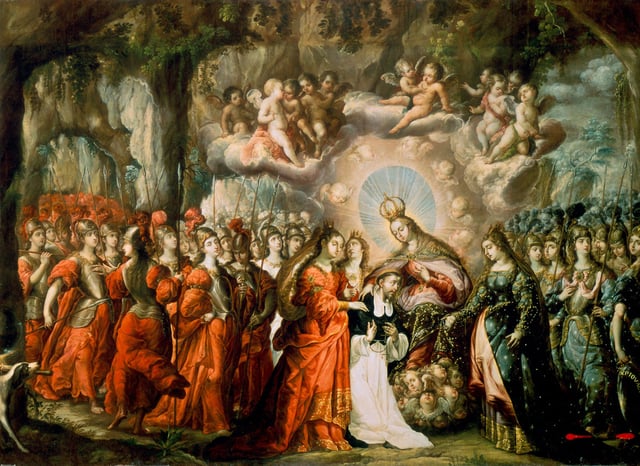
The art of the Colonial Mexico (center of New Spain) developed a large number of painters born in Mexico.
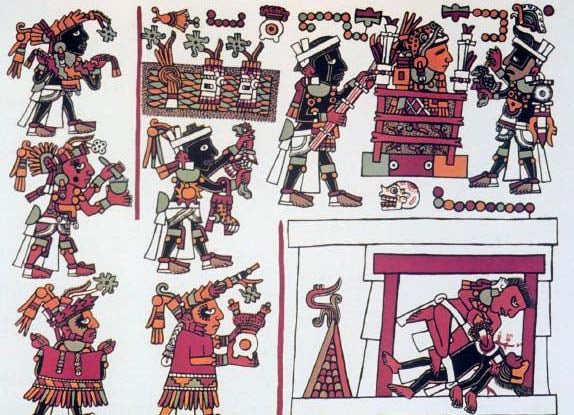
Many codices made both during Pre-hispanic Mexico and in the Spanish colony are preserved.
Painting is one of the oldest arts in Mexico. Cave painting in Mexican territory is about 7500 years old and has been found in the caves of the Baja California Peninsula. Pre-Hispanic Mexico is present in buildings and caves, in Aztec codices, in ceramics, in garments, etc..; examples of this are the Maya mural paintings of Bonampak, or those of Teotihuacán, those of Cacaxtla and those of Monte Albán.
Mural painting had an important flowering during the 16th century; the same in religious constructions as in houses of lineage; such is the case of the convents of Acolman, Actopan, Huejotzingo, Tecamachalco and Zinacantepec. It is said that they were mainly indigenous painters led by friars who made them. These were also manifested in illustrated manuscripts such as the Matrícula de Tributos.
For a time it was believed that the first European painter living in New Spain was Rodrigo de Cifuentes, an apocryphal artist who even came to be attributed works such as Caciques de Tlaxcala, painting of the main altarpiece of the Convent of San Francisco in Tlaxcala. Among the native painters was Marcos Aquino. The religiosity of the Novohispanos ("New-Spanish") made that the painting was important for the evangelization of the society, the friars realized the graphic skills of the natives, who enriched the baroque and mannerist style. The arrival of several European painters and some students from New Spain, such as Juan Correa, Cristóbal de Villalpando or Miguel Cabrera, who made the walls and altarpieces the main source of the ideological and political expression of artists.
The painting of the 19th century had a very marked romantic influence; landscapes and portraits were the greatest expressions of this era.
Hermenegildo Bustos is one of the most appreciated painters of the historiography of Mexican art. Other painters in these years were Santiago Rebull, José Salomé Pina, Félix Parra, Eugenio Landesio and his famous disciple, the landscaper José María Velasco Gómez, as well as Julio Ruelas.[407]
Mexican painting of the 20th century has achieved world renown with figures such as David Alfaro Siqueiros, José Clemente Orozco, Joaquín Clausell, Frida Kahlo and Diego Rivera, a generation of idealists who marked the image of modern Mexico in the face of strong social and economic criticism. The Oaxacan School quickly gained fame and prestige, diffusion of ancestral and modern culture. Freedom of design is observed in relation to the color and texture of the canvases and murals as a period of transition between the 20th century and the 21st century.
Some of the most outstanding painters in the 21st century (current painters): Patricia Calvo Guzmán studied painting in Beijing.
Her work, of marked oriental influence, recalls the cut paper figures of Mexico and China, mixing them with a rich chromatic range; Eliseo Garza Aguilar, painter and performer considered among the leading exponents of the provocative and reflective art of the Third Millennium. In search of a critical response from the spectators, he combines his pictorial work in the performances with theatrical histrionics. Pilar Goutas is a painter who uses oil on amate support, with strong influence from Jackson Pollock and Chinese calligraphy. Rafael Torres Correa settled in Mexico in 2001 and joined the contemporary art workshop "La Polilla" in Guadalajara, producing various plastic and scenographic projects.
Throughout history several prominent painters of different nationalities have expressed in their works the face of Mexico.
Among the most outstanding we can mention are Daniel Thomas Egerton, Carl Nebel, Thomas Moran, Édouard Manet and Leonora Carrington.
Sculpture
From the Spanish conquest, civil and religious sculpture is worked by indigenous artists, with guidance from teachers of the peninsula, so some pre-Hispanic features are shown.
Since the 17th century, white and mestizo sculptors have created works with a marked influence of European classicism.
Romanticism tended to break the strict norms and models of classicism, as it pursued ideas influenced by realism and nationalism.
The religious sculpture was reduced to a sporadic imagery, while the secular sculpture continued in portraits and monumental art of a civic nature.
Between 1820 and 1880 the predominant themes were, successively: religious images, biblical scenes, allegories to the symbols of the insurgency movement and scenes and characters of pre-Cortesian history, and portraits of the old aristocracy, of the nascent bourgeoisie and commanders of the pre-revolution.
The transcendent was to introduce civil reasons, the first national types and glimpses of a current of self-expression.
During the 20th century, great exponents of Mexican sculpture are Juan Soriano, José Luis Cuevas, Enrique Carbajal (Sebastián), English Leonora Carrington.
Architecture
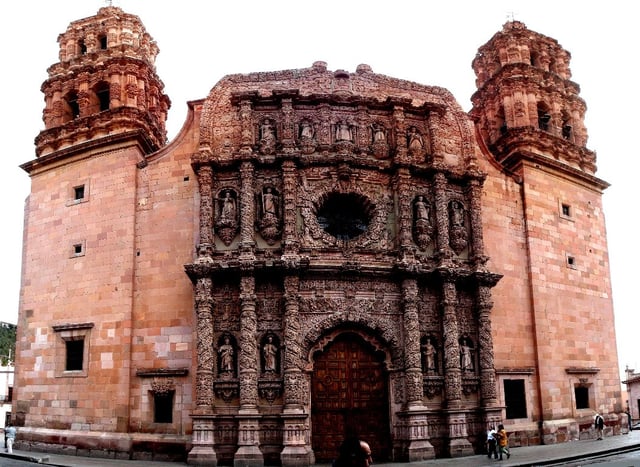
Cathedral Basilica of Zacatecas
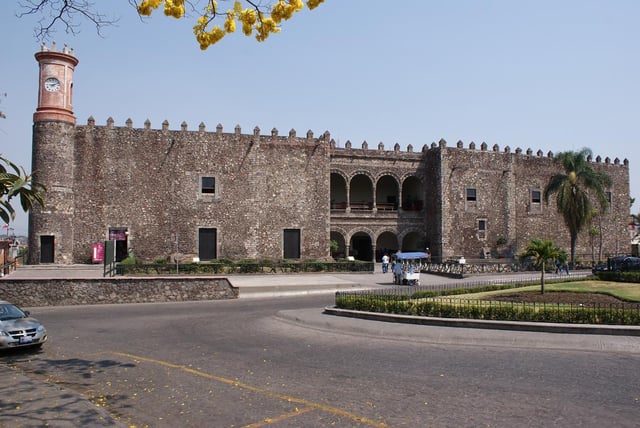
Palace of Cortés, Cuernavaca, is the oldest conserved colonial-era civil building in the continental Americas.

Teotihuacán, State of Mexico
The presence of the human being in the Mexican territory has left important archaeological findings of great importance for the explanation of the habitat of primitive man and contemporary man.
The Mesoamerican civilizations managed to have great stylistic development and proportion on the human and urban scale, the form was evolving from simplicity to aesthetic complexity; in the north of the country the adobe and stone architecture is manifested, the multifamily housing as we can see in Casas Grandes; and the troglodyte dwelling in caves of the Sierra Madre Occidental.
Urbanism had a great development in pre-Hispanic cultures, where we can see the magnitude of the cities of Teotihuacán, Tollan-Xicocotitlan and México-Tenochtitlan, within the environmentalist urbanism highlight the Mayan cities to be incorporated into the monumentality of its buildings with the thickness of the jungle and complex networks of roads called sakbés.
With the arrival of the Spaniards, architectural theories of the Greco-Roman order with Arab influences were introduced.
Due to the process of evangelization, when the first monastic temples and monasteries were built, their own models were projected, such as the mendicant monasteries, unique in their type in architecture.
The interaction between Spaniards and natives gave rise to artistic styles such as the so-called tequitqui (from Nahuatl: worker). Years later the baroque and mannerism were imposed in large cathedrals and civil buildings, while rural areas are built haciendas or stately farms with Mozarabic tendencies.
In the 19th century the neoclassical movement arose as a response to the objectives of the republican nation, one of its examples are the Hospicio Cabañas where the strict plastic of the classical orders are represented in their architectural elements, new religious buildings also arise, civilian and military that demonstrate the presence of neoclassicism. Romanticists from a past seen through archeology show images of medieval Europe, Islamic and pre-Hispanic Mexico in the form of architectural elements in the construction of international exhibition pavilions looking for an identity typical of the national culture. The art nouveau, and the art deco were styles introduced into the design of the Palacio de Bellas Artes to mark the identity of the Mexican nation with Greek-Roman and pre-Hispanic symbols.
Modern architecture in Mexico has an important development in the plasticity of form and space, José Villagrán García develops a theory of form that sets the pattern of teaching in many schools of architecture in the country within functionalism. The emergence of the new Mexican architecture was born as a formal order of the policies of a nationalist state that sought modernity and the differentiation of other nations. Juan O'Gorman was one of the first environmental architects in Mexico, developing the "organic" theory, trying to integrate the building with the landscape within the same approaches of Frank Lloyd Wright.[408] In the search for a new architecture that does not resemble the styles of the past, it achieves a joint manifestation with the mural painting and the landscaping.
The Jalisco School was a proposal of those socio-political movements that the country demanded.
Luis Barragán managed to combine the shape of the space with forms of rural vernacular architecture of Mexico and Mediterranean countries (Spain-Morocco), integrating an impressive color that handles light and shade in different tones and opens a look at the international minimalism.
Mexican architecture is a cultural phenomenon born of the ideology of nationalist governments of the 20th century, which was shaping the identity image by its colorful and variegated ornamental elements inherited from ancestral cultures, classical and monumental forms and, subsequently, the incorporation of modernism and cutting-edge international trends.
The Mexican (Lo mexicano)
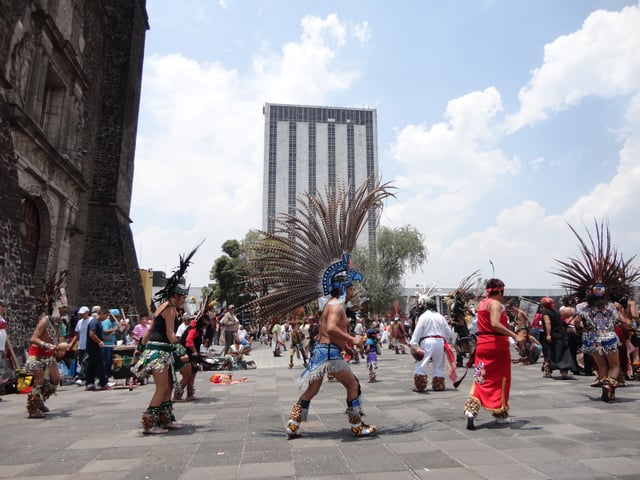
The Plaza de las Tres Culturas in Mexico City, which combines architectural styles representing three major cultural periods: pre-Columbian, colonial, and independent Mexico.
In ethnic and cultural terms, Lo mexicano corresponds only to everything that is referred to the Aztec culture; therefore, ethnically Mexicans are those who are also known as Nahuas and whose language is Nahuatl.[409] There is a strong discussion to define The Mexican (Lo mexicano); there are two completely divided aspects: ethnic and cultural, which focuses exclusively on the Mesoamerican people called Mexica people, and the legal-administrative aspect of the territory called Mexico. In legal terms and in accordance with the Constitution, a Mexican is a citizen born within the territory of the United Mexican States or whoever has decided adopt the Mexican citizenship.
The Mexican could be what characterizes the being of Mexico and its people; however, it is an ethnic concept that only defines the mestizo identity that had been related for a long time and that is limited with respect to the ethnic diversity of the country. It is an intellectual construction product of the approaches of specialists to the cultural reality of the country. In trying to capture in a single figure the multicultural reality of Mexico, the result of the intellectual analysis has produced a series of stereotypes and truisms about what it is to be a Mexican. This discourse about The Mexican has been used in the political field to legitimize power, and at the same time it is imposed on the population of the country as a fact beyond all doubt.
The intellectual construction of the mestizo is in dialogue with the triumph of revolutionary nationalism, which was born after the Mexican Revolution. In the reflection on the subject (the character of the Mexican, the mexicanity, the definition of a Mexican) have participated, among others: José Vasconcelos,[410] Samuel Ramos,[411] Emilio Uranga,[412] José Gaos, Leopoldo Zea, Jorge Portilla, Santiago Ramírez, Salvador Pérez Nevares, Roger Bartra, José del Val, Arturo Warman, Aniceto Aramoni, Rogelio Díaz Guerrero, Ezequiel Adeodato Chávez Lavista, Mauro Rodríguez Estrada and Carlos Chilpa Navarrete.[413] Octavio Paz]], author of *.
Literature
Mexican literature has its antecedents in the literature of the indigenous settlements of Mesoamerica.
Poetry had a rich cultural tradition in prehispanic Mexico, being divided into two broad categories—secular and religious.
Aztec poetry was sung, chanted, or spoken, often to the accompanyment of a drum or a harp.
While Tenochtitlan was the political capital, Texcoco was the cultural center; the Texcocan language was considered the most melodious and refined. The best well-known prehispanic poet is Nezahualcoyotl.[414]
Literature during the 16th century consisted largely of histories of Spanish conquests, and most of the writers at this time were from Spain.
Bernal Díaz del Castillo's Historia verdadera de la conquista de la Nueva España (True history of the Conquest of New Spain) is still widely read today. Francisco de Terrazas, who wrote sonnets, was the first Mexican-born poet to attain renown.[415] Baroque Literature flourished in the 17th century; the most notable writers of this period were Juan Ruiz de Alarcón and Juana Inés de la Cruz.[415] The 18th and early 19th centuries gave us José Joaquín Fernández de Lizardi, whose The Mangy Parrot ("El Periquillo Sarniento"), is said to be the first Latin American novel. Several Jesuit humanists wrote at this time, and they were among the first to call for independence from Spain.[415]
Other writers include Alfonso Reyes, José Joaquín Fernández de Lizardi, Ignacio Manuel Altamirano, Carlos Fuentes, Octavio Paz (Nobel Laureate), Renato Leduc, Carlos Monsiváis, Elena Poniatowska, Mariano Azuela ("Los de abajo") and Juan Rulfo ("Pedro Páramo"). Bruno Traven wroteCanasta de cuentos mexicano (Mexican tales basket) and El tesoro de la Sierra Madre (Treasure of the Sierra Madre). Luis Spota, Jaime Sabines, Martín Luis Guzmán, and Valeria Luiselli (Faces in the Crowd) are also noteworthy.[416]
Visual arts
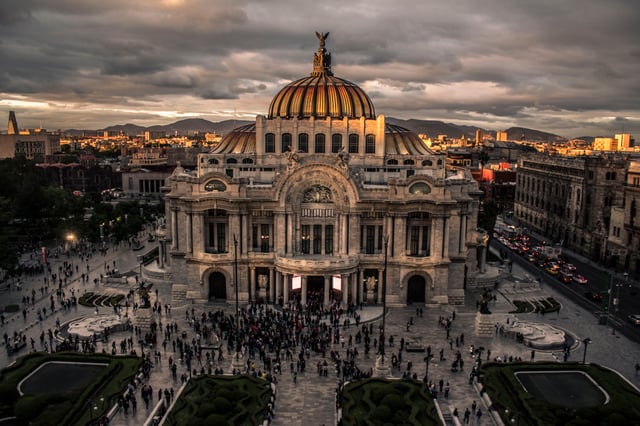
The Palacio de Bellas Artes is the preeminent fine arts hall in Mexico.
Post-revolutionary art in Mexico had its expression in the works of renowned artists such as David Alfaro Siqueiros, Federico Cantú Garza, Frida Kahlo, Juan O'Gorman, José Clemente Orozco, Diego Rivera, and Rufino Tamayo. Diego Rivera, the most well-known figure of Mexican muralism, painted the Man at the Crossroads at the Rockefeller Center in New York City, a huge mural that was destroyed the next year because of the inclusion of a portrait of Russian communist leader Lenin.[417] Some of Rivera's murals are displayed at the Mexican National Palace and the Palace of Fine Arts.
Mesoamerican architecture is mostly noted for its pyramids which are the largest such structures outside of Ancient Egypt. Spanish Colonial architecture is marked by the contrast between the simple, solid construction demanded by the new environment and the Baroque ornamentation exported from Spain. Mexico, as the center of New Spain has some of the most renowned buildings built in this style.
Cinema
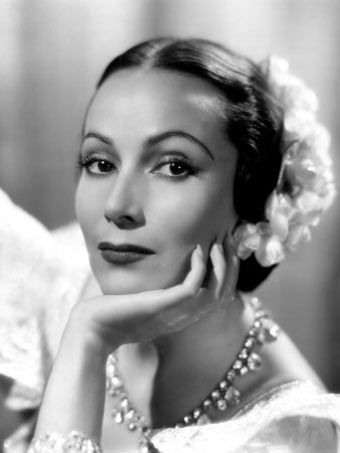
Actress Dolores del Río, Hollywood star in the 1920s and 1930s and prominent figure of the Golden Age of Mexican cinema in the 1940s and 1950s
Mexican films from the Golden Age in the 1940s and 1950s are the greatest examples of Latin American cinema, with a huge industry comparable to the Hollywood of those years. Mexican films were exported and exhibited in all of Latin America and Europe. Maria Candelaria (1943) by Emilio Fernández, was one of the first films awarded a Palme d'Or at the Cannes Film Festival in 1946, the first time the event was held after World War II. The famous Spanish-born director Luis Buñuel realized in Mexico between 1947 and 1965 some of his masterpieces like Los Olvidados (1949) and Viridiana (1961). Famous actors and actresses from this period include María Félix, Pedro Infante, Dolores del Río, Jorge Negrete and the comedian Cantinflas.
More recently, films such as Como agua para chocolate (1992), Cronos (1993), Y tu mamá también (2001), and Pan's Labyrinth (2006) have been successful in creating universal stories about contemporary subjects, and were internationally recognized, as in the prestigious Cannes Film Festival. Mexican directors Alejandro González Iñárritu (Amores perros, Babel, Birdman, The Revenant), Alfonso Cuarón (Children of Men, Harry Potter and the Prisoner of Azkaban, Gravity), Guillermo del Toro, Carlos Carrera (The Crime of Father Amaro), screenwriter Guillermo Arriaga and photographer Emmanuel Lubezki are some of the most known present-day film makers. Numerous Mexican actors have achieved recognition as Hollywood stars.[418]
Media
There are three major television companies in Mexico that own the primary networks and broadcast covering all nation, Televisa, TV Azteca and Imagen Television. Televisa is also the largest producer of Spanish-language content in the world and also the world's largest Spanish-language media network.[275] Media company Grupo Imagen is another national coverage television broadcaster in Mexico, that also owns the newspaper Excélsior. Grupo Multimedios is another media conglomerate with Spanish-language broadcasting in Mexico, Spain, and the United States. The telenovelas are very traditional in Mexico and are translated to many languages and seen all over the world with renowned names like Verónica Castro, Lucía Méndez and Thalía.
Music

Mariachi group playing at the 10th anniversary celebration of Wikipedia in Guadalajara. Mariachi is a musical expression inscribed in the UNESCO Intangible Cultural Heritage List in 2011.
Mexican society enjoys a vast array of music genres, showing the diversity of Mexican culture.
Traditional music includes mariachi, banda, norteño, ranchera and corridos; on an everyday basis most Mexicans listen to contemporary music such as pop, rock, etc. in both English and Spanish. Mexico has the largest media industry in Latin America, producing Mexican artists who are famous in Central and South America and parts of Europe, especially Spain.
Cuisine
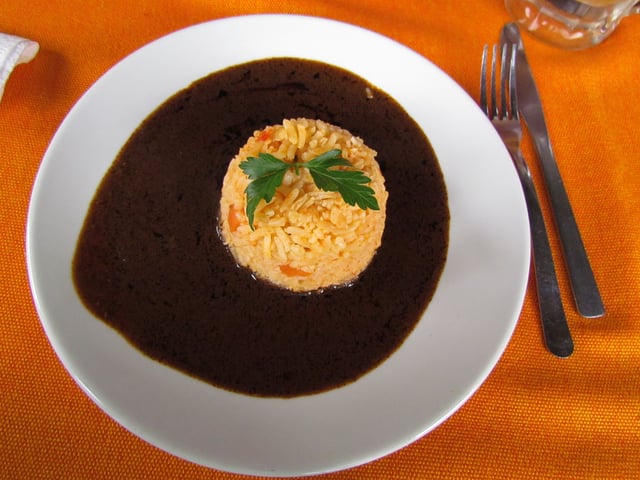
Mole sauce, which has dozens of varieties across the Republic, is seen as a symbol of Mexicanidad [421] and is considered Mexico's national dish.[421]

The first chocolate version (liquid) was made by indigenous people in present-day Mexico, and was exported from Mexico to Europe after the Spanish conquest.[420]
In 2005, Mexico presented the candidature of its gastronomy for World Heritage Site of UNESCO, being the first occasion in which a country had presented its gastronomic tradition for this purpose.[422] However, in a first instance the result was negative, because the committee did not place the proper emphasis on the importance of corn in Mexican cuisine.[423] Finally, on November 16, 2010 Mexican gastronomy was recognized as Intangible cultural heritage by UNESCO.[424] In addition, Daniela Soto-Innes was named the best female chef in the world by The World's Best 50 Restaurants in April 2019.[425]
The origin of the current Mexican cuisine is established during the Spanish colonization, being a mixture of the foods of Spain with native indigenous ingredients.[426] Of foods originated in Mexico is the corn, the pepper vegetables (together with Central and South America), calabazas (together with the Americas), avocados, sweet potato (together with Central and South America), the turkey (together with the Americas) and other fruits and spices. Other Indigenous products are many beans. Similarly, some cooking techniques used today are inherited from pre-Hispanic peoples, such as the nixtamalization of corn, the cooking of food in ovens at ground level, grinding in molcajete and metate. With the Spaniards came the pork, beef and chicken meats; peppercorn, sugar, milk and all its derivatives, wheat and rice, citrus fruits and another constellation of ingredients that are part of the daily diet of Mexicans.
From this meeting of millennia old two culinary traditions, were born pozole, mole sauce, barbacoa and tamale is in its current forms, the chocolate, a large range of breads, tacos, and the broad repertoire of Mexican street foods. Beverages such as atole, champurrado, milk chocolate and aguas frescas were born; desserts such as acitrón and the full range of crystallized sweets, rompope, cajeta, jericaya and the wide repertoire of delights created in the convents of nuns in all parts of the country.
Sports

The Estadio Azteca, regarded as one of the iconic football stadiums in the world, hosted the 1970 and 1986 World Cup finals
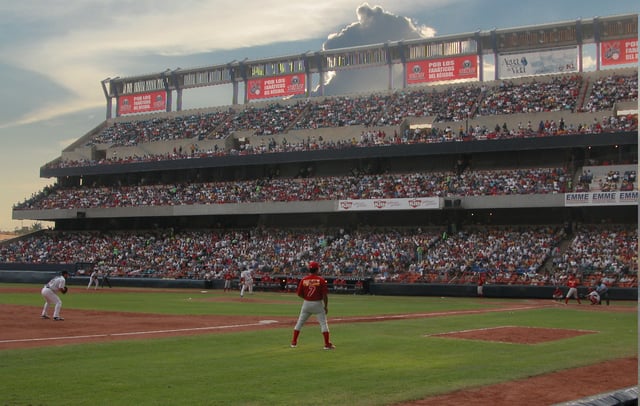
Game at the Estadio de Béisbol Monterrey. Baseball is most popular in the North (particularly Northwest) and Southeast of Mexico.
Mexico's most popular sport is association football.
It is commonly believed that football was introduced in Mexico by Cornish miners at the end of the 19th century. By 1902 a five-team league had emerged with a strong British influence.[427][428] Mexico's top clubs are América with 12 championships, Guadalajara with 11, and Toluca with 10.[429] Antonio Carbajal was the first player to appear in five World Cups,[430] and Hugo Sánchez was named best CONCACAF player of the 20th century by IFFHS.[431] Rafael Márquez is the only Mexican to have won the Champions League.[432]
The Mexican professional baseball league is named the Liga Mexicana de Beisbol. While usually not as strong as the United States, the Caribbean countries and Japan, Mexico has nonetheless achieved several international baseball titles.[433][434] Mexican teams have won the Caribbean Series nine times. Mexico has had several players signed by Major League teams, the most famous of them being Dodgers pitcher Fernando Valenzuela.[432]
Mexico City hosted the XIX Olympic Games in 1968, making it the first Latin American city to do so.[435] The country has also hosted the FIFA World Cup twice, in 1970 and 1986.[436]
In 2013, Mexico's basketball team won the Americas Basketball Championship and qualified for the 2014 Basketball World Cup where it reached the playoffs. Because of these achievements the country earned the hosting rights for the 2015 FIBA Americas Championship.[437]
Bullfighting (Spanish: corrida de toros) came to Mexico 500 years ago with the arrival of the Spanish. Despite efforts by animal rights activists to outlaw it, bullfighting remains a popular sport in the country, and almost all large cities have bullrings. Plaza México in Mexico City, which seats 45,000 people, is the largest bullring in the world.[438]
Professional wrestling (or Lucha libre in Spanish) is a major crowd draw with national promotions such as AAA, CMLL and others.[432]
Coat of arms
The current coat of arms of Mexico (Spanish: Escudo Nacional de México, literally "national shield of Mexico") has been an important symbol of politics and culture of Mexico for centuries. It depicts a Mexican golden eagle perched on a prickly pear cactus devouring a rattlesnake.[441] The design is rooted in the legend that the Aztec people would know where to build their city once they saw an eagle eating a snake on top of a lake.[441] To the people of Tenochtitlan, this symbol had strong religious connotations, and to the Europeans, it came to symbolize the triumph of good over evil (with the snake sometimes representative of the serpent in the Garden of Eden).
Health
Since the early 1990s, Mexico entered a transitional stage in the health of its population and some indicators such as mortality patterns are identical to those found in highly developed countries like Germany or Japan.[442] Mexico's medical infrastructure is highly rated for the most part and is usually excellent in major cities,[443][444] but rural communities still lack equipment for advanced medical procedures, forcing patients in those locations to travel to the closest urban areas to get specialized medical care.[176] Social determinants of health can be used to evaluate the state of health in Mexico.
State-funded institutions such as Mexican Social Security Institute (IMSS) and the Institute for Social Security and Services for State Workers (ISSSTE) play a major role in health and social security. Private health services are also very important and account for 13% of all medical units in the country.[445]
Medical training is done mostly at public universities with much specializations done in vocational or internship settings.
Some public universities in Mexico, such as the University of Guadalajara, have signed agreements with the U.S. to receive and train American students in Medicine. Health care costs in private institutions and prescription drugs in Mexico are on average lower than that of its North American economic partners.[443]
Education
The National Autonomous University of Mexico ranks 103th in the QS World University Rankings, making it the best university in Mexico, after it comes the Monterrey Institute of Technology and Higher Education as the best private school in Mexico and 158th worldwide in 2019.[449] Private business schools also stand out in international rankings. IPADE and EGADE, the business schools of Universidad Panamericana and of Monterrey Institute of Technology and Higher Education respectively, were ranked in the top 10 in a survey conducted by The Wall Street Journal among recruiters outside the United States.[450]
See also
Index of Mexico-related articles
Outline of Mexico
Mexico – Wikipedia book